My 3-Day Florence Itinerary: A Practical Guide for First-Timers

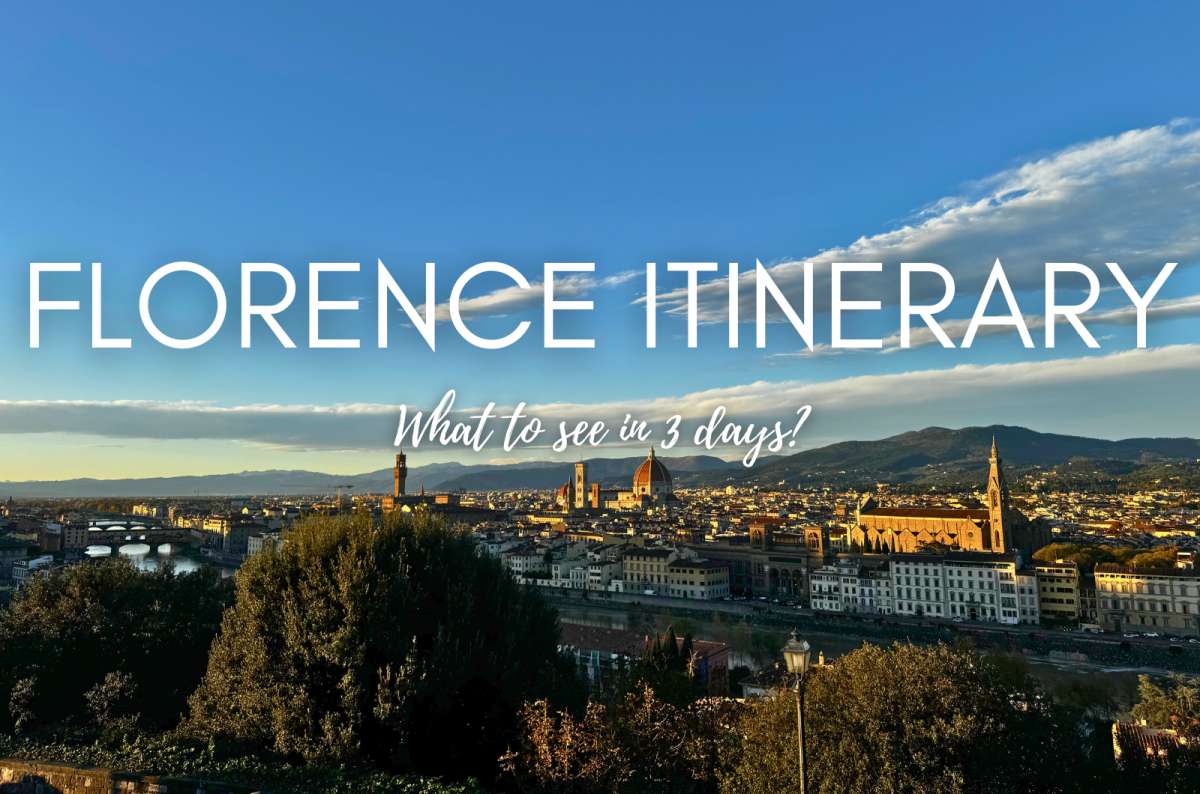
Overview of 3-Day Florence Itinerary: Step-by-step
Where I stayed in Florence: I Vivai
Day 1 of Your 3-Day Florence Itinerary—Duomo, David & the Florence Heavyweights
Stop 1, day 1: Florence Cathedral— Duomo di Firenze, Dome Climb & Full Ticket Guide (3–4 hours)
Stop 2, day 1: Galleria dell’Accademia—Where to Find Michelangelo’s David (45 minutes)
Optional stop 3: Bargello Gallery Florence—Hidden Gem for Renaissance Sculpture in Florence (1 hour)
Stop 4, day 1: Piazza della Signoria + Palazzo Vecchio (30 minutes)
Day 2 of Your 3-Day Florence Itinerary— Uffizi, Oltrarno Views, and Sunset Spots
Stop 2, day 2: Ponte Vecchio—Florence’s Iconic Bridge (10 minutes)
Stop 3, day 2: Uffizi Gallery–Botticelli, Da Vinci & Must-See Renaissance Art in Florence (2 hours)
Stop 4, day 2 (optional): Vasari Corridor—Florence’s Secret Passage (45 minutes)
Stop 6, day 2: Piazzale Michelangelo & San Miniato—The best sunset spot in Florence (45 minutes)
Stop 1, day 3: Santa Maria Novella—Florence’s Gothic Church with a Famous Facade (15–30 minutes)
Stop 3, day 3: Mercato Centrale– Florence’s Best Food Market? (1 hour)
Stop 5, day 3: Museo Galileo–A Florence Must-See for Science Nerds (1 hour)
Have More Time? The Best Day Trips from Florence
How many days do you need in Florence?
What is the best way to get around Florence?
What’s better: climbing the Dome or the Bell Tower?
What’s included in the Duomo complex ticket?
Do I need to buy tickets in advance for Florence attractions?
This Florence itinerary is exactly what I wish I had when I was researching my own trip, because I felt that every blog out there shares the same ten Florence must-sees, but I knew there has to be more to it than that.
I was pretty sure that after the third museum, my brain would be melting and I would no longer be able to tell them apart anyway, so I needed MORE. More variety, more options, more confidence that I'll really figure out what to see in Florence in 3 days and not skip the good parts.
That’s why I made this—a realistic, tested 3-day Florence itinerary. I’ve broken everything down so it’s easy to follow and doesn’t feel like work. All the big sights are here—the Duomo, Uffizi, David, Santa Croce—but spaced out with other stops where you can catch a breath and enjoy the city. Every stop is something I actually did and loved myself.
Read more from my Italy travel blog.
What You’ll Get in This Itinerary:
-
A full 3-day Florence itinerary based on my real trip
-
Times, entry prices, and what to reserve in advance
-
Notes on what to skip if you’re tired or just not feeling it
-
Daily walking maps so you don’t zigzag like an idiot
-
Optional day trips if you’re staying in Florence longer
This is how to see Florence in 3 days:
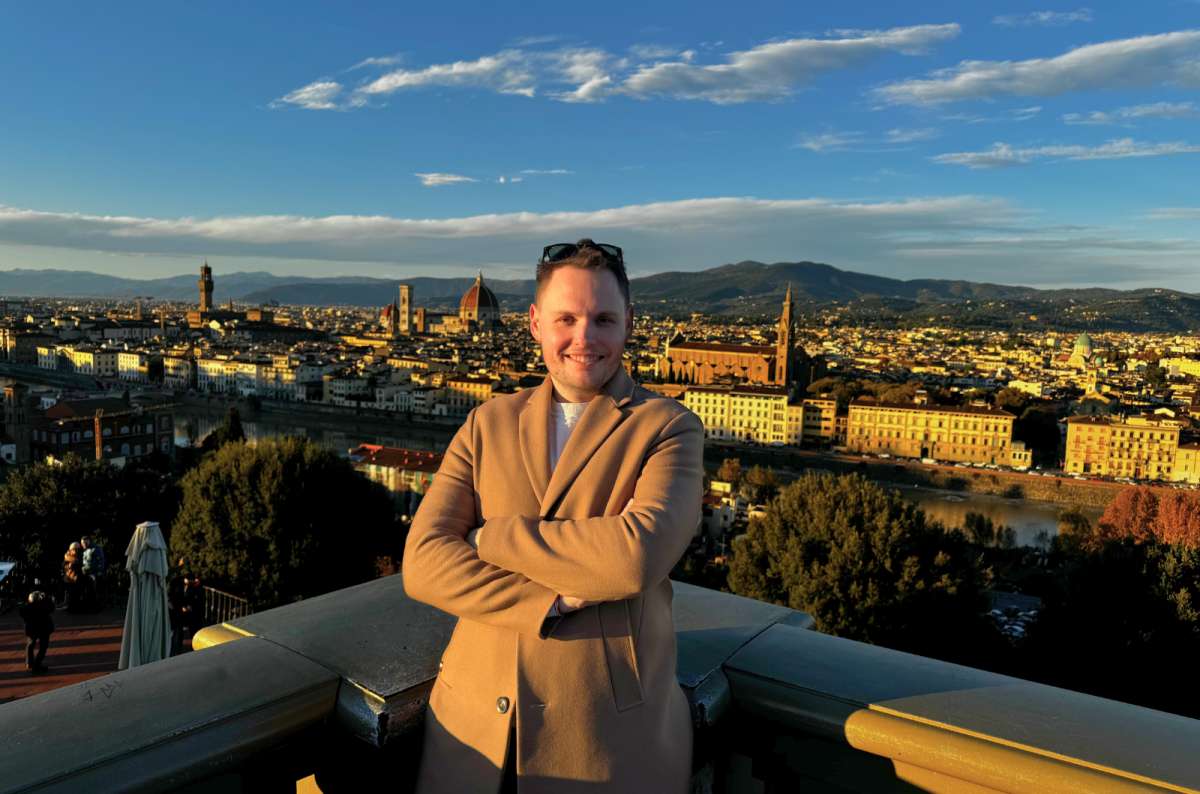
The best views of Florence @ Piazzale Michelangelo
Overview of 3-Day Florence Itinerary: Step-by-step
Day 1–Historic Core & Most Important Landmarks
-
Stop 1: Florence Cathedral (Duomo Complex)
-
Stop 2: Galleria dell’Accademia for Michelangelo’s David
-
Optional: Bargello Gallery Florence for even more sculpture, including Donatello’s earlier David
-
Stop 3: Piazza della Signoria + Palazzo Vecchio
-
Stop 4: Dinner: Outside Florence at Osteria di Casa Chianti–truffle overload, worth the detour
Day 2–Uffizi, Old Town Squares & Views
-
Stop 1: Santa Croce Basilica–tombs of Michelangelo and Galileo
-
Stop 2: Ponte Vecchio (the bridge that’s really a building)
-
Stop 3: Uffizi Gallery
-
Stop 4: Vasari Corridor (optional)
-
Stop 5: Palazzo Pitti + Boboli Gardens (or swap for Bardini)
-
Stop 6: Sunset: Piazzale Michelangelo + San Miniato al Monte
Day 3–Unique Spots, Markets & Science
-
Stop 1: Santa Maria Novella Basilica
-
Stop 2: San Lorenzo Basilica + Medici Chapels
-
Stop 3: Mercato Centrale (central market)
-
Bonus stop: Officina Profumo-Farmaceutica di Santa Maria Novella—the oldest pharmacy in the world and Piazza della Repubblica
-
Stop 4: Orsanmichele Church & Museum
-
Stop 5: Museo Galileo
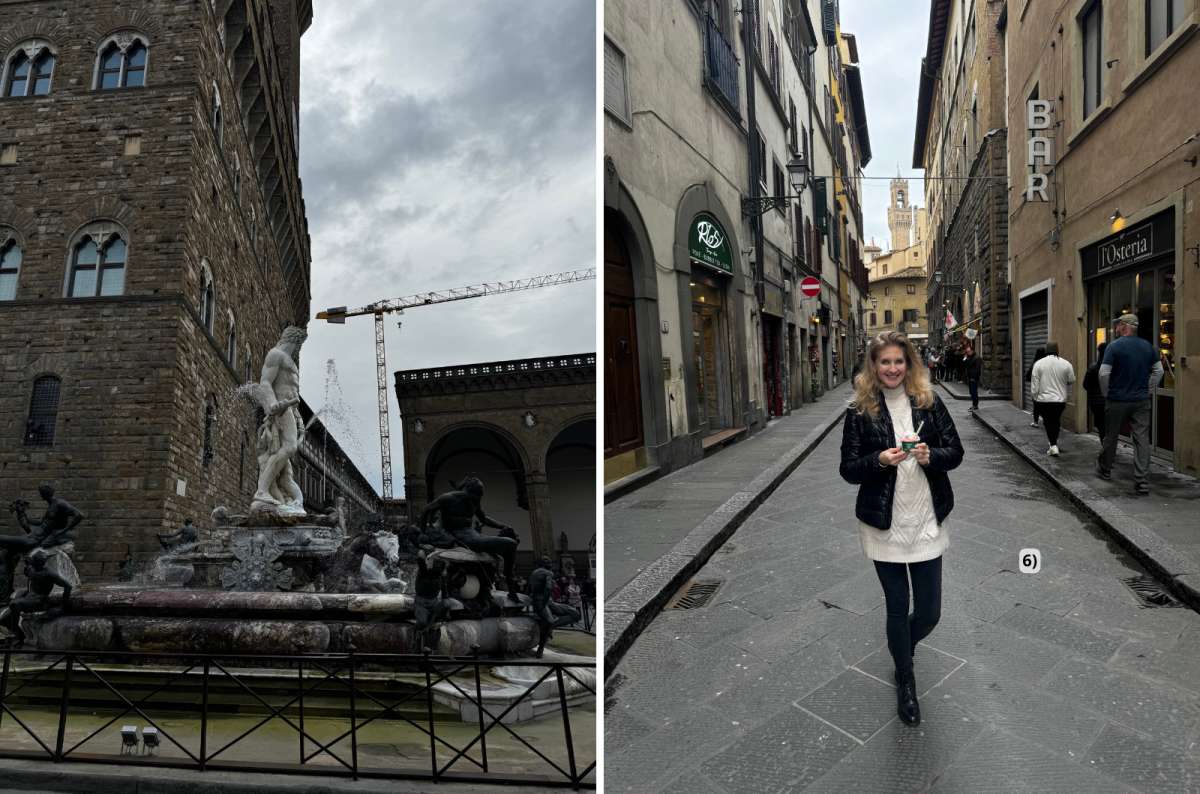
Exploring Florence’s hidden alleys and iconic piazzas
Sometimes, all you need to do is take the first step... I've filtered out the best hotels in Florence for you
Save it for yourself to come back to later, or share with your friends on social media!
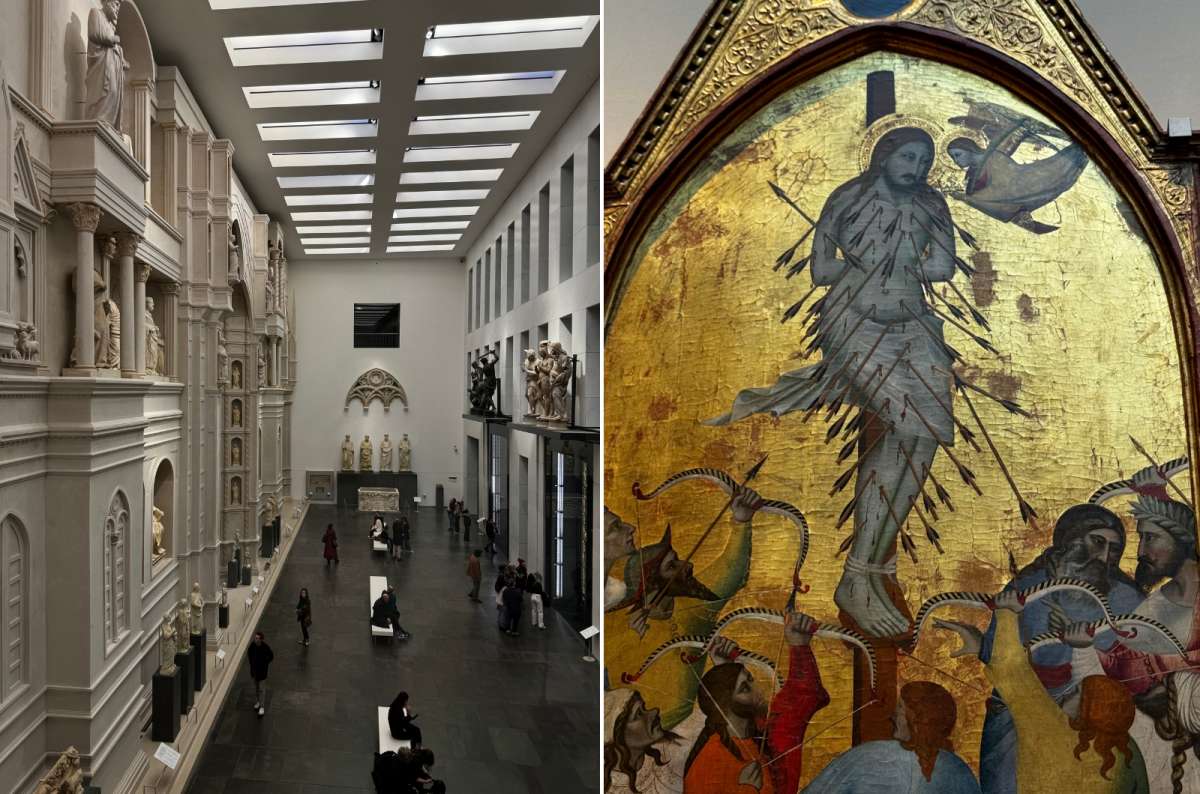
Museo dell’Opera del Duomo–this hall, known as the “Hall of Paradise” recreates the Duomo’s original façade
Where I stayed in Florence: I Vivai
I got a room at I Vivai, a hotel just outside the Old Town, right by the highway—I was road-tripping through Tuscany, so the location was perfect. Parking in Florence city center is a ZTL parking nightmare, so you will want a hotel with a garage or parking lot. Rooms were big (especially by Italian standards), though the breakfast was just average. Still, I’d stay there again.
Here’s what to see in Florence in 3 days, based on my experience:
Day 1 of Your 3-Day Florence Itinerary—Duomo, David & the Florence Heavyweights

Start your 3 day Florence itinerary with a walk through the city’s historic core and major sights like the Florence Cathedral and Piazza della Signoria

Starting the day at Piazza del Duomo—Florence’s jaw-dropping centerpiece and the ultimate first stop on your Florence itinerary
Main sites visited:
-
Duomo Complex
-
Galleria dell’Accademia
-
(Optional) Bargello Gallery Florence
-
Piazza della Signoria + Palazzo Vecchio
-
Truffle dinner in the hills outside Florence
Restaurant tip:
- Osteria di Casa Chianti–out in the hills, heavy on truffle dishes, book ahead
Hotel recommendation:
I started day 1 of this 3 day Florence itinerary with the city’s star attractions—the Duomo complex and Michelangelo’s David. These are two of the most essential things to do in Florence, so it makes sense to see them out first while you’re still fresh and actually able to feel something.
Stop 1, day 1: Florence Cathedral— Duomo di Firenze, Dome Climb & Full Ticket Guide (3–4 hours)
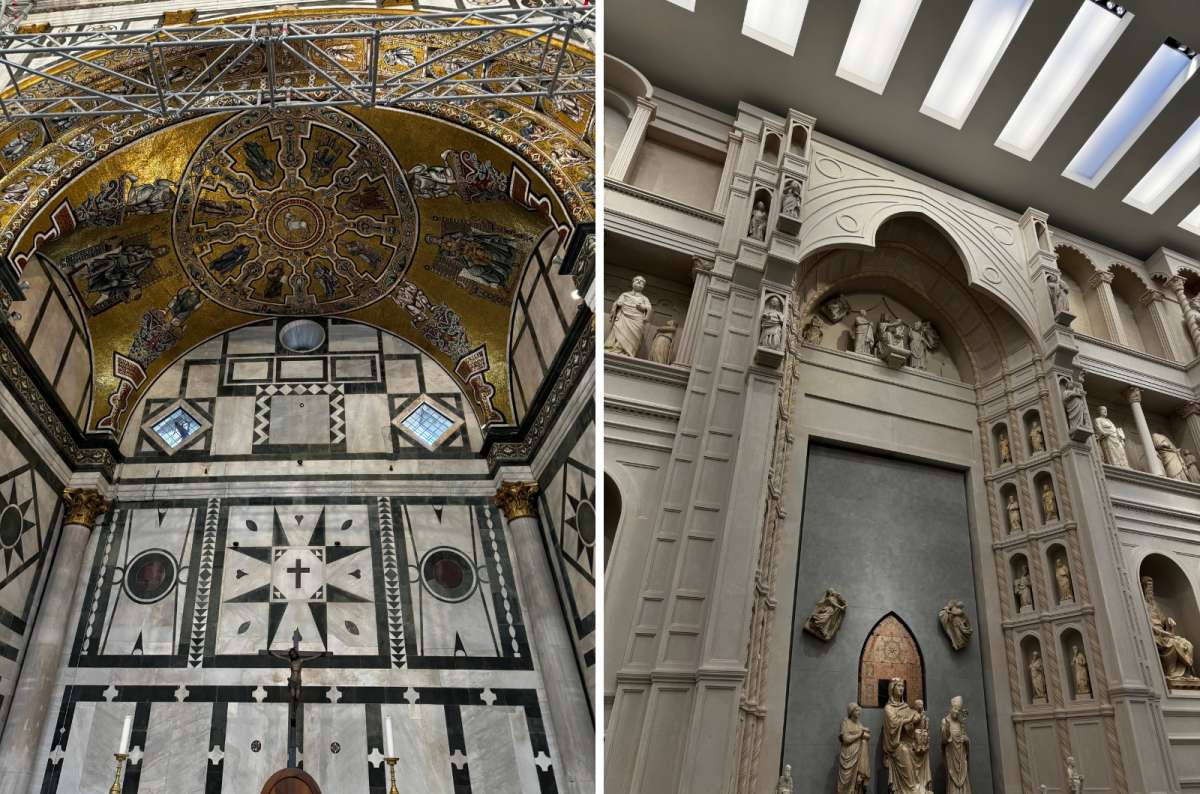
Up close to the Baptistery’s glittering mosaics and Renaissance masterpieces at the Opera del Duomo—Florence’s Duomo complex revealed
- Time spent here: 3–4 hours
- Book in advance? Yes, a month in advance
Visitor information:
- Price: EUR 30 for combo ticket
- Opening hours: Monday to Saturday, 10:15 am to 3:45 pm
This first stop at Florence’s top attraction will take up at least a third of your day. Because when people say they’re “going to see the Duomo,” they usually mean everything around it too. It’s a whole cluster of religious sites smashed into a single square:
-
the actual cathedral (Santa Maria del Fiore)
-
the bell tower (Giotto’s Campanile)
-
the Baptistery
-
the underground ruins of Santa Reparata
-
and the Museo dell’Opera del Duomo
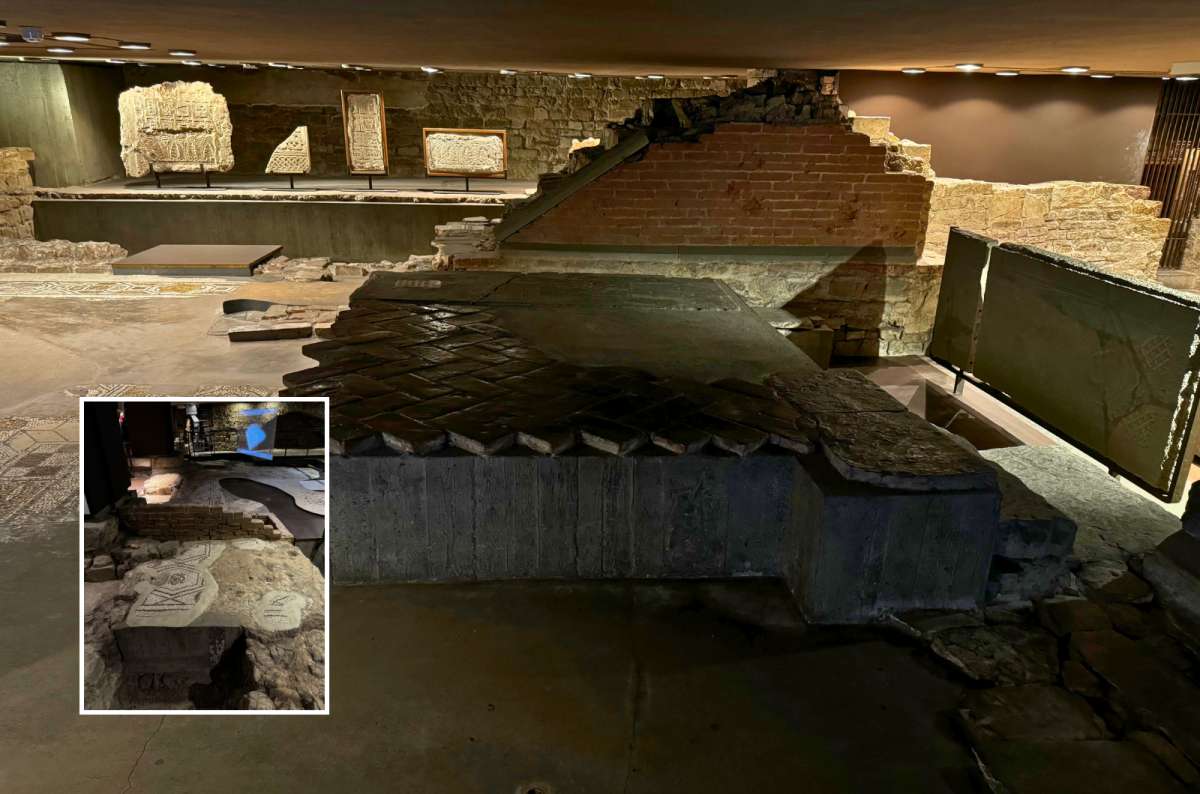
Exploring the hidden crypt of Santa Reparata under Piazza del Duomo
Florence’s Duomo is absolutely massive. It's also the prettiest cathedral I’ve ever seen.
Pro tip: If you want to climb Brunelleschi’s Dome, book very early, like a month in advance. I tried to reserve a spot two weeks ahead in the off-season and there was no chance. The dome climb is sold as part of a combo ticket, which includes everything above, but the dome time slot is the first thing to disappear. And so, I missed it.
What I saw at the Duomo complex:
-
Giotto’s Bell Tower (30–45 minutes): A must-do in Florence. I climbed this first thing in the morning to avoid baking to death. The exterior of the Campanile is a gorgeous pink tone because of the marble it’s built out of. It’s 414 steps to the top and they get narrower the higher you go. I stopped at the 3 platforms on the way up to take in the unique views of the cathedral—it almost fits into the frame from here! Absolutely incredible, as are the views of Florence, which looks deceptively compact from here. Views are slightly obstructed by fencing that had to be put up to prevent people from jumping down to a certain death.
-
Inside the Cathedral (15 minutes): I literally only spent 15 minutes in the actual cathedral. It’s huge, but pretty bare on the inside. Of course there’s the dome fresco overhead—heaven and hell, lots of writhing bodies, standard Renaissance stuff.
-
Santa Reparata (25 minutes): Way more interesting is this underground portion of the cathedral. There are remnants of Roman stonework and bases of ancient walls, cool mosaics, and a few tombs and sarcophagi with nameplates and skeletal outlines.
-
Baptistery (5 minutes): Famous for the gold ceiling and “Gates of Paradise” bronze doors. Unfortunately, it was half-covered in scaffolding when I went. Of course it was. So, sadly, there’s not much I can report.
-
Museo dell’Opera del Duomo (45–60 minutes): Besides the bell tower, this was the best part of my Duomo visit. It’s where they keep originals of the bronze doors, Donatello’s very tired-looking Mary Magdalene, and even a full-sized model of what the old cathedral façade looked like. Beware it’s 30 rooms over several floors. Inside, there’s genuinely interesting info about the cathedral. A huge chunk of the museum is (rightfully) dedicated to Brunelleschi’s dome, since it was a ridiculous architectural achievement at the time. It’s interesting to notice how obsessed Renaissance architects were with the Romans—they really saw them as ancient geniuses who built miracles.
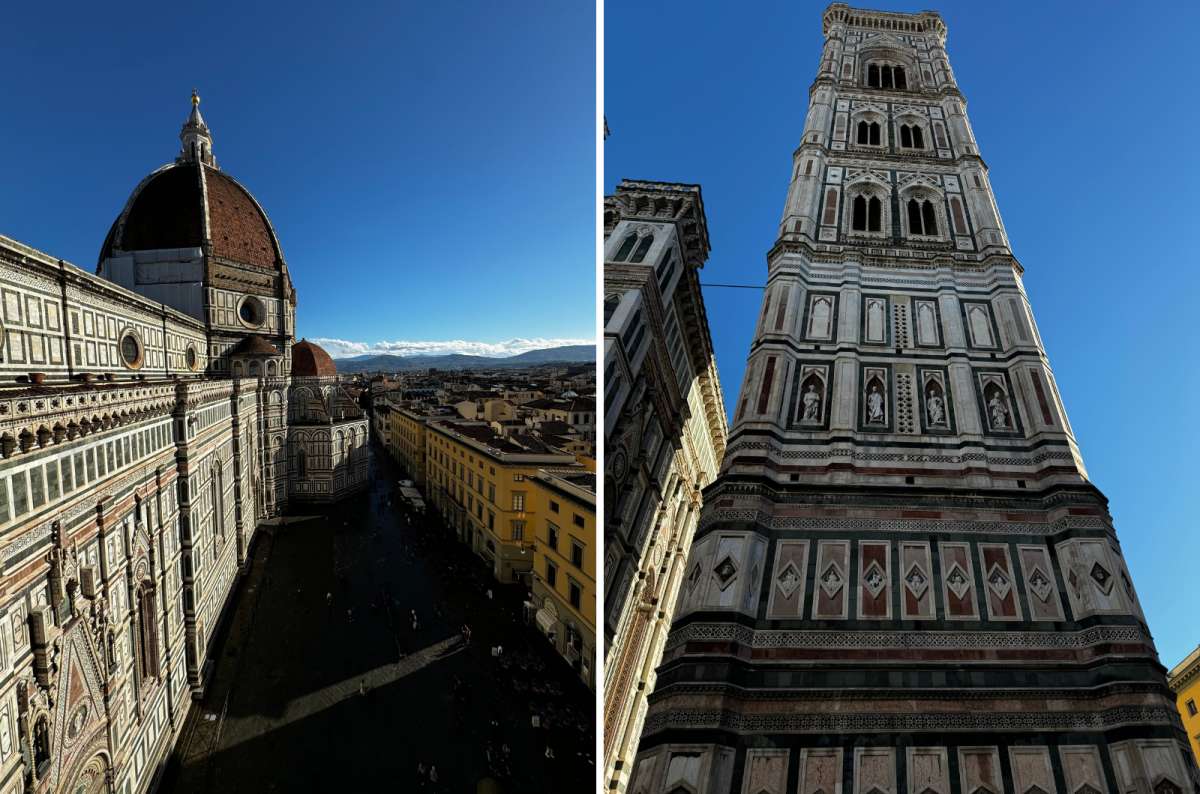
Climbing inside Giotto’s Campanile—marble details up close in the heart of Piazza del Duomo
Practical tips for visiting the Duomo Complex
-
Buy the combo ticket (EUR 30 with dome climb, EUR 20 without) online in advance. It covers all five sites.
-
Dome reservations go fast—book at least a month ahead in high season.
-
Use the lockers—you’ll be required to put your bags into the lockers at the entrance.
-
Museum last: It’s the best place to end your visit once you’ve seen the real buildings.
-
Skip the cathedral interior if you're tight on time. It looks better from the outside.
Is the Duomo worth it?
Yes—but not for the reasons you think. You need to get the combo ticket and explore beyond the cathedral: do the bell tower climb (and the Dome climb if you can get a time slot) and the underground Santa Reparata ruins, and don’t miss the museum.
Next, visit Michelangelo’s David.
Stop 2, day 1: Galleria dell’Accademia—Where to Find Michelangelo’s David (45 minutes)
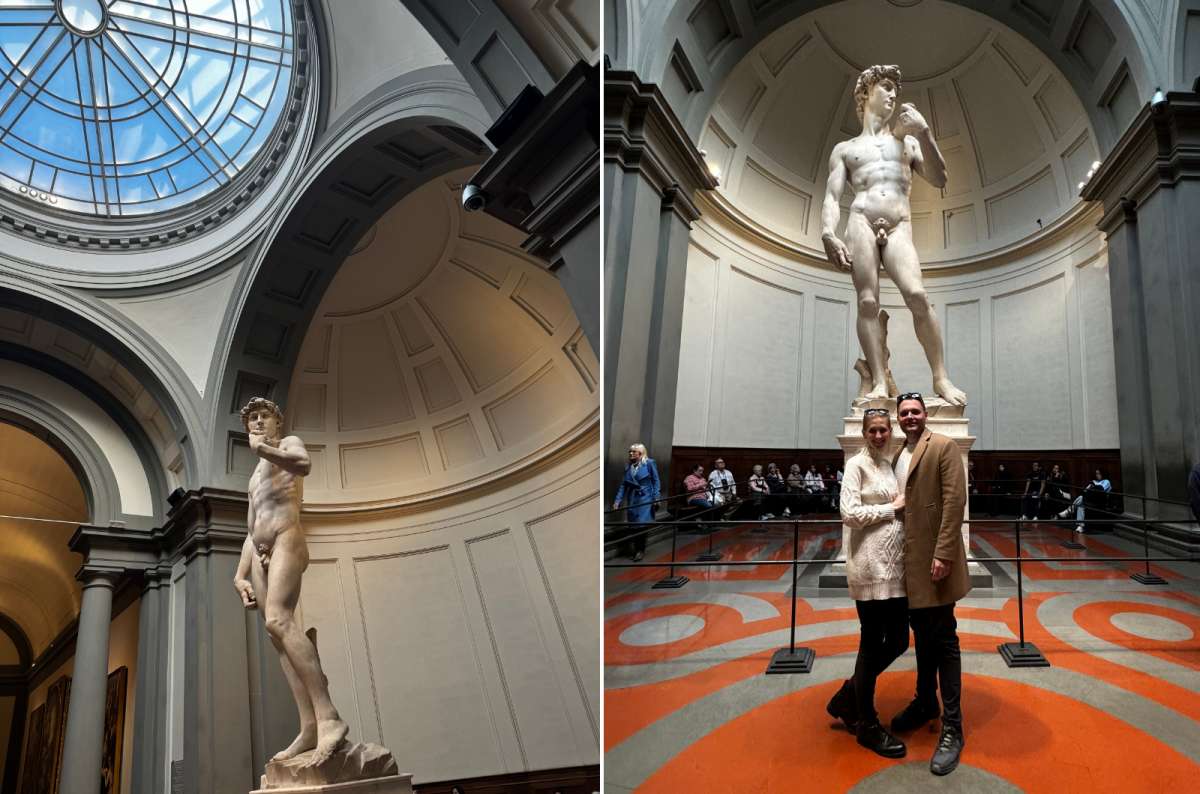
Florence’s Renaissance icon in all its glory (notice the ladies in the back getting the money shot of those glutes)
- Distance from last stop: 450 meters / 0.28 miles, 6-minute walk
- Time spent here: 45 minutes
- Book in advance? Yes, in high season. Expect lines in low season.
Visitor information:
- Tickets: EUR 16
- Opening hours: Daily from 8.15 am to 6:20pm
Now you get exactly 6 minutes to stretch your legs and breathe, because that’s how long it’ll take you to get to your next stop on this Florence itinerary: the Galleria dell’Accademia, aka home of Michelangelo’s David.
Don’t be confused—the David statue outside is a copy. Don’t stop there.
If you are asking if seeing Michelangelo’s David is worth it, YES, he is spectacular. Surprisingly huge, too.
The gallery David is in is small and full of people, no matter the season. You’ll need to book in advance in high season, but I found just showing up and standing in line worked just fine in low season.
When I walked in, I was greeted by a sea of religious paintings. If you bother to look and not just make a mad dash to the real David, you’ll find some odd gems—peacock-feathered angels, smug saints crushing sinners.
I was floored by how big David is—5 m (17 ft) tall. He’s carved from marble most sculptors thought was impossible to sculp out of, which shows Michelangelo’s genius. Every muscle, vein, and tendon is freakishly perfect. You‘ll get it even if you don’t care about art.
I heard multiple times, usually with giggles from a lady’s mouth, that the statue has a good butt. So there’s that too, I guess.
The hall also features other unfinished human sculptures, which is actaully pretty fascinating when you compare them to the one and only David.
There’s also a music museum inside with some weird and wonderful old instruments. It was a welcome break from all the paintings and statues for 15 minutes.
Optional stop 3: Bargello Gallery Florence—Hidden Gem for Renaissance Sculpture in Florence (1 hour)

Stepping into the historic courtyard of the Bargello—Florence’s top Renaissance sculpture museum with medieval charm
- Distance from last stop: 450 meters / 0.28 miles, 6-minute walk
- Time spent here: 45 minutes to an hour
- Book in advance? Yes, in high season. In low season, you can get in with a short wait
Visitor information:
- Tickets: EUR 10
- Opening hours: Daily except Tuesday 8:15am–6:50 pm, on Sunday 1:50 pm–5:50 pm
If you have the energy and patience for more statues, go to Florence’s Bargello Museum (Museo Nazionale del Bargello). It’s nearby and way less crowded than Galleria dell’Accademia.
It’s got Donatello’s David, some Michelangelo, and a whole bunch of sculptures that nobody is crowding in to see. A good second-tier museum. Not essential, but if you’re trying to see all of Florence’s top museums, it belongs on the itinerary.
(I admit to skipping it because it came at a time in my own Florence itinerary where the museums were starting to turn into an artsy blur.)
Stop 4, day 1: Piazza della Signoria + Palazzo Vecchio (30 minutes)
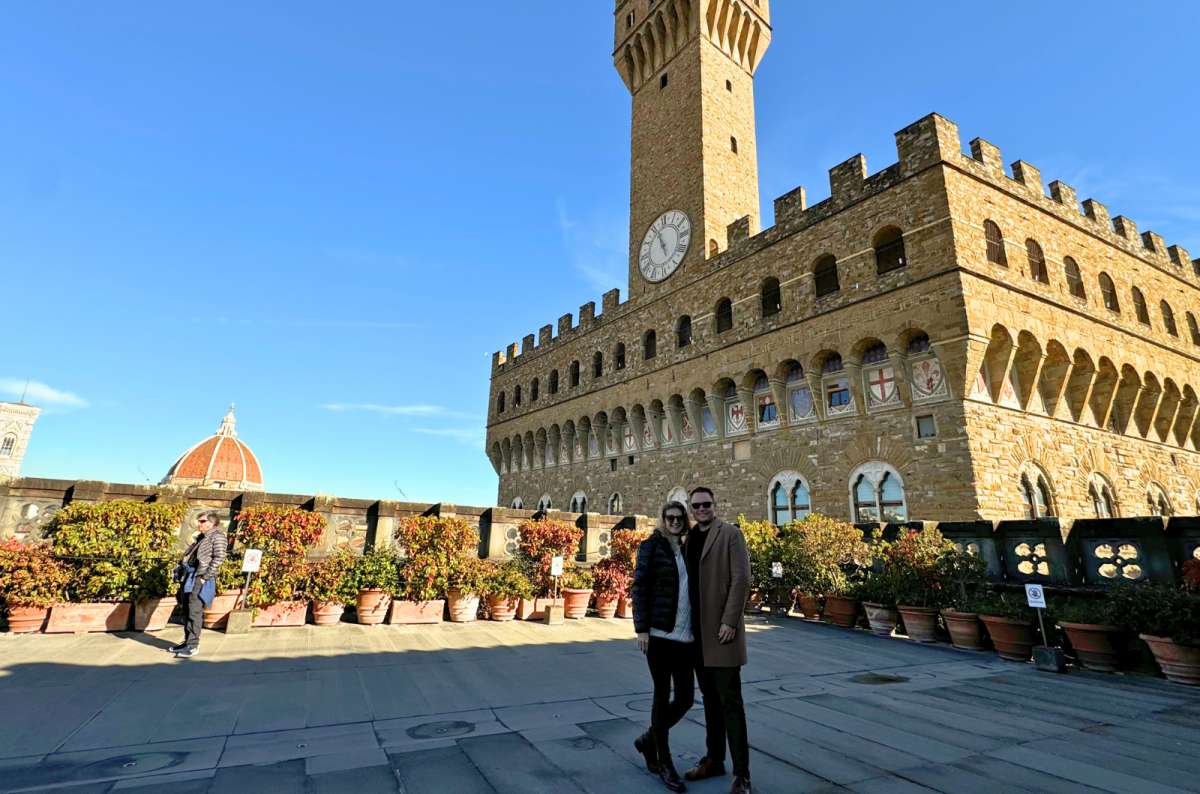
When the view is so iconic you forget your legs are burning from all the stairs @ Palazzo Vecchio
- Distance from last stop: 230 meters / 0.14 miles, 3-minute walk
- Time spent here: 20 minutes for just a wander around the square
- Book in advance? No
Visitor information for Palazzo Vecchio:
- Tickets: EUR 12.50 (if you decide to return and go inside)
- Opening hours: Daily 9:00 am–7:00 pm and on Thursdays 9:00–2:00 pm
Ok, finally a spot on this first day in Florence that isn’t a museum (well, kind of)! Instead, this is one of the most photogenic places in Florence.
Piazza della Signoria is square where the buildings are old, the facades are either yellow or naked bricks, and the atmosphere is lively. Spot what is probably the fifth fake David I'd seen by now, Neptune peeing in a fountain, and other statues that would be the highlight of any other city.
The prominent piece of architecture to stare at here is definitely Palazzo Vecchio. This is Florence’s old town hall... but remember this is one of Italy’s old-money fashion capitals, so it’s also a full-blown Renaissance palace, complete with frescoed ceilings, secret rooms, and an art museum.
We went inside and could still whip out enough enthusiasm to appreciate the large art collection. FOr me, Michelangelo’s sketches were especially cool to see.
But for this 3-day Florence itinerary, you can choose to just look at the town hall from the outside. Come back to this museum on another day if you happen to have extra time in Florence that you’re just dying to fill with art.
It’s time for dinner in the Tuscan hills!
Dinner at Osteria di Casa Chianti–Truffle Coma in the Hills

Truffles, truffles everywhere! @ Casa di Chianti
We left Florence proper and drove out into the hills to eat at Osteria di Casa Chianti—where you can get truffle everything: tartare, tagliolini, tagliata with rib-eye. The service was genuinely kind, and everyone spoke good English without making you feel like an idiot for not speaking Italian (it happens occasionally). The food was heavenly. And truffle-y.
Pro tip: No good restaurants in Florence open before 7pm.

Day 2 of Your 3-Day Florence Itinerary— Uffizi, Oltrarno Views, and Sunset Spots
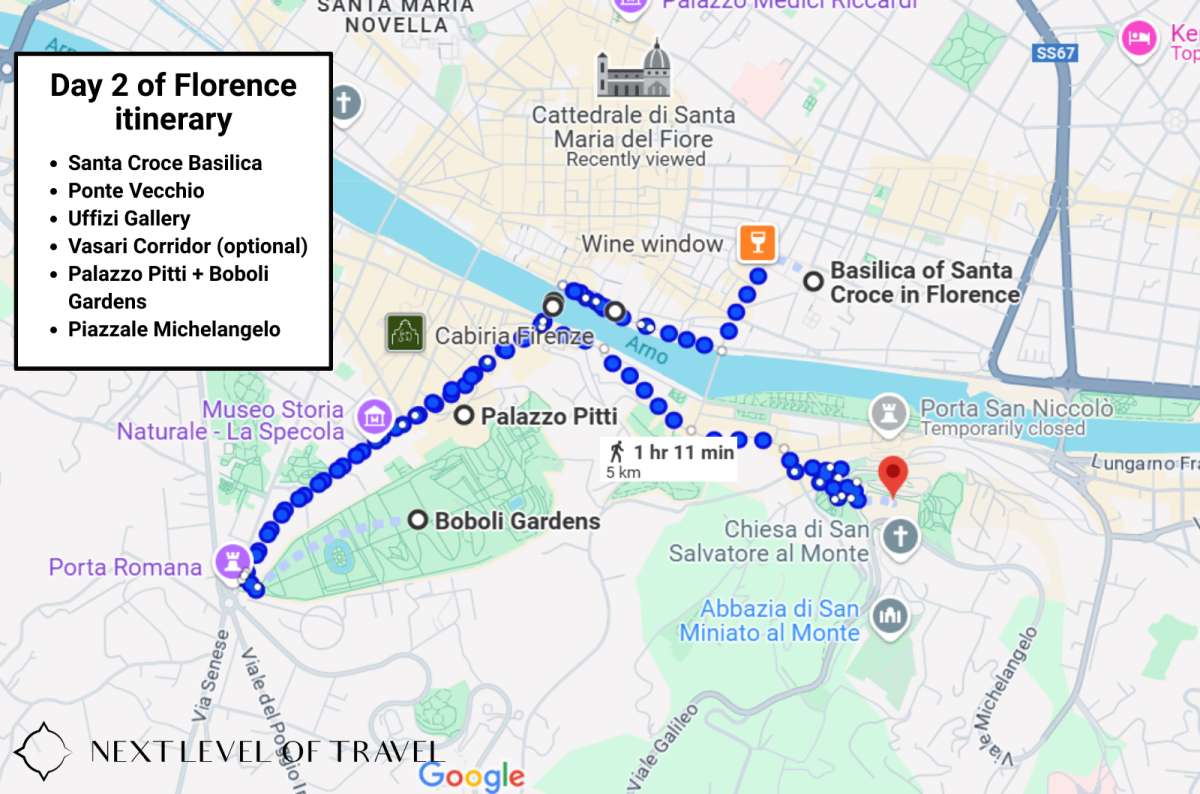
Your 3 days in Florence itinerary wouldn’t be complete without art, bridges, and panoramic Oltrarno views
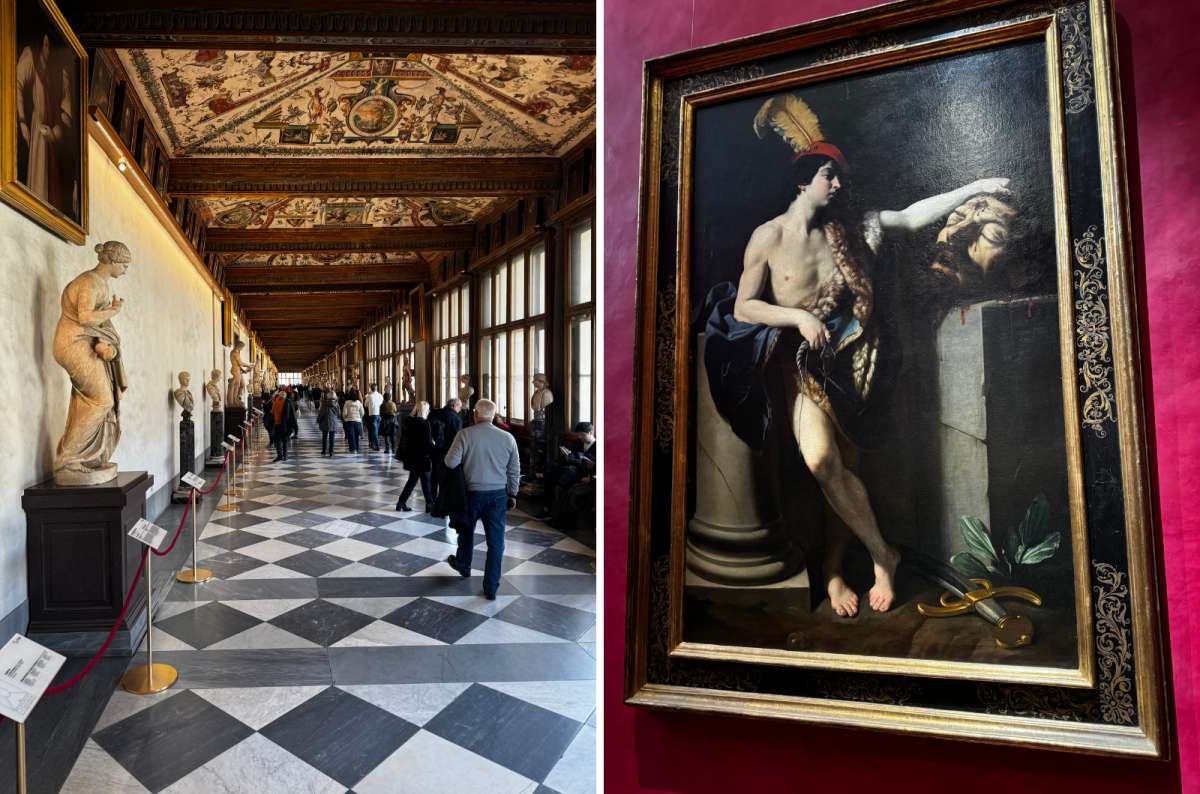
The Uffizi Gallery is one of the oldest museums in the world, originally built in 1560 for Florentine magistrates—not masterpieces
Day 2 of this 3-day Florence itinerary is means art, architecture, river views, and one very crowded bridge. A great mix, if I do say so myself. We wandered through Santa Croce, crossed Ponte Vecchio, tackled the Uffizi, and ended up at Piazzale Michelangelo just in time to fight for a sunset photo.
Main sites visited:
-
Santa Croce Basilica
-
Ponte Vecchio
-
Uffizi Gallery
-
Vasari Corridor (optional)
-
Palazzo Pitti + Boboli Gardens
-
Piazzale Michelangelo + San Miniato
Restaurant tip:
- Trattoria in Oltrarno or near Piazza Santo Spirito–avoid tourist traps
Hotel recommendation:
Stop 1, day 2: Santa Croce Basilica & Complex—Michelangelo’s Tomb & Florence’s Other Big Church (30 minutes)
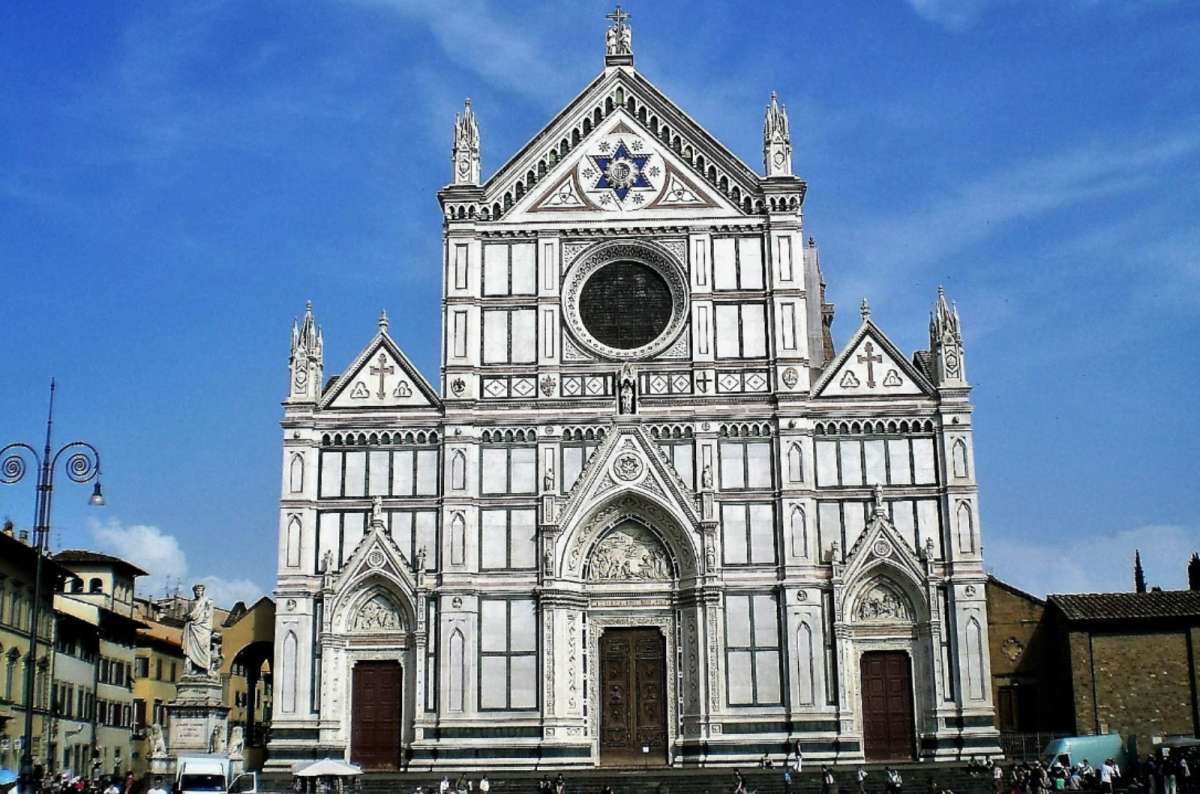
Basilica di Santa Croce in Florence—final resting place of legends like Michelangelo and Galileo
- Time spent here: 30 minutes
- Book in advance? No.
Visitor information:
- Tickets: EUR 10
- Opening hours: From Monday to Saturday 9:30 am–5:30 pm and on Sunday 12:30 pm–5:45 pm

Resting place of legends @ Santa Croce in Florence
I hyped up Santa Croce in my mind so much that I ended up a tad disappointed. It was one of those places that looks way fancier in photos than in real life. It’s nice, but I already got that wow effect at the Duomo the day before and then Santa Croce fell a bit flat in comparison.
Why visit Santa Croce
Like the Duomo, Santa Croce isn’t just a church, but a whole complex of buildings and courtyards. Strangely, the basilica is like a graveyard with a roof over its head. The floor is covered with tombstones. Even stranger, you just walk right over them.
And then there’s the fancy-pants tombs where Michelangelo, Galileo, and Machiavelli are buried, and that alone made it worth the EUR 10 entry for me.
It all takes maybe 30 minutes to walk through.
A note on dress code at Santa Croce: Your shoulders and knees are supposed to be covered, though I saw some men in questionably short shorts and nobody told them off. I did notice kimono-type cover-ups you could borrow at the entrnace if you need an extra layer.
Pro tip: Santa Croce is close to Gelateria dei Neri, which is excellent. I grabbed a gelato here before heading to my next stop.
Should I skip Santa Croce?
It depends on how much you care about tombs. It’s not the flashiest church, but it’s where Michelangelo, Galileo, and Machiavelli are buried. If you're even slightly into history, it's a pretty church with a nice courtyard worth 30 minutes.
Next, walk through the classic Florentine alleyways and make your way to another famous landmark in Florence: the Vecchio Bridge.
Stop 2, day 2: Ponte Vecchio—Florence’s Iconic Bridge (10 minutes)
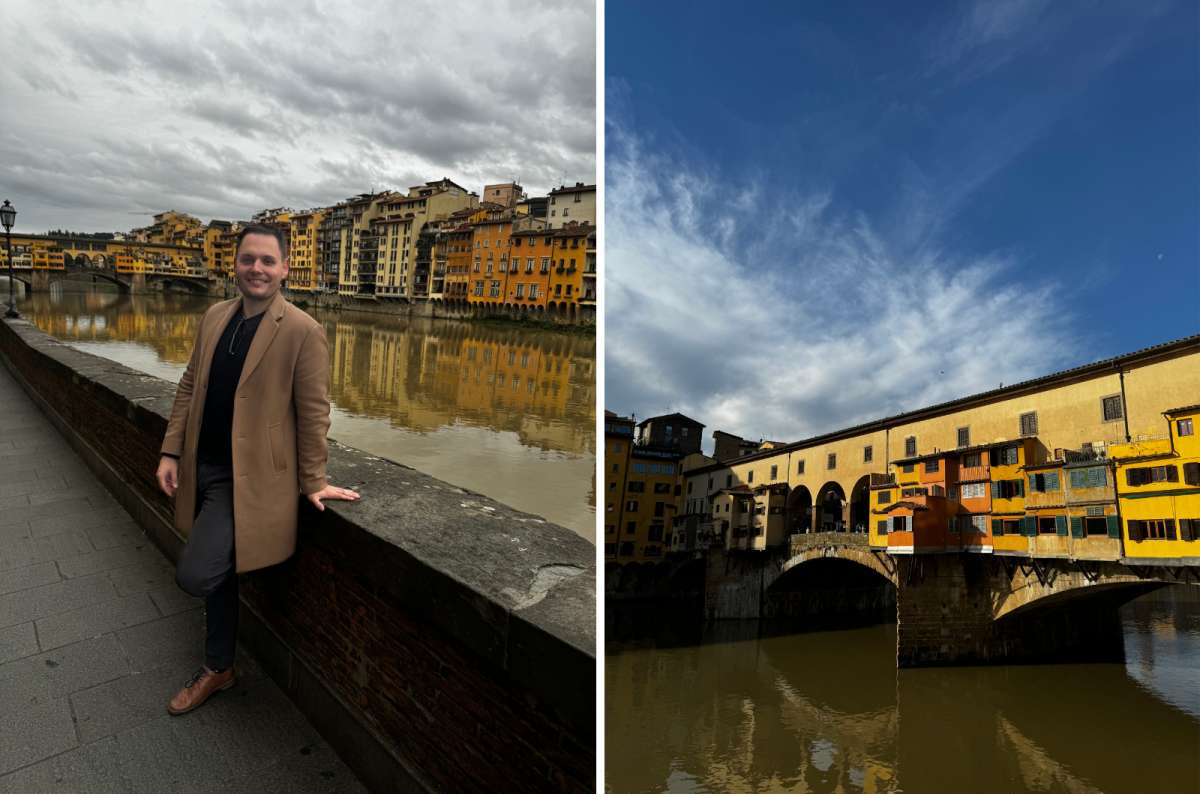
Ponte Vecchio: the bridge that’s actually a building on the water
- Distance from last stop: 600 meters / 0.37 miles—about an 8-minute walk
- Time spent here: 10 minutes
- Book in advance? No
Ultimately, I was heading into the Uffizi, but first, I made a quick stop at Ponte Vecchio, Florence’s oldest and most photographed bridge. It’s one of those places that everyone tells you to see, and then you see it... and, well, that’s all there is to it.
Yes, there are shops built directly on top of the bridge—oddly just gold and jewelry stores now, which replaced the butchers and tanners the Medici kicked out centuries ago (apparently, they couldn’t stand the smell).
You walk it, look around, and move on. I found it super interesting, but there’s little to do in a few minutes.
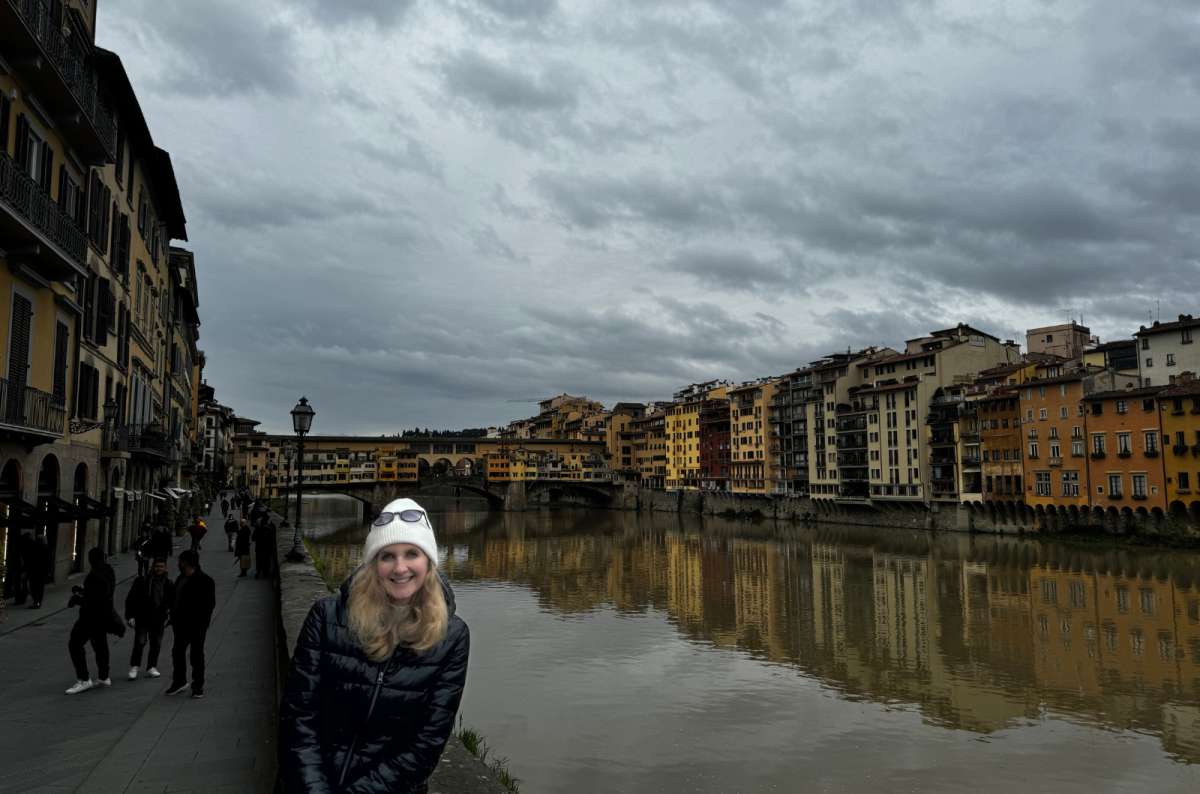
Smiling by the Arno River with Ponte Vecchio in the background
Pro tip: For the best view of Ponte Vecchio, walk over to Ponte Santa Trinita and look back from there.
The Vasari Corridor is part of Ponte Vecchio
Above the shops, you’ll see a narrow hallway with tiny windows—that’s the Vasari Corridor, which connects the Uffizi on one side of the Arno River to the Pitti Palace on the other. You’ll actually walk it later if you’ve booked the combined ticket, but for now, just know it’s there.

Stop 3, day 2: Uffizi Gallery–Botticelli, Da Vinci & Must-See Renaissance Art in Florence (2 hours)
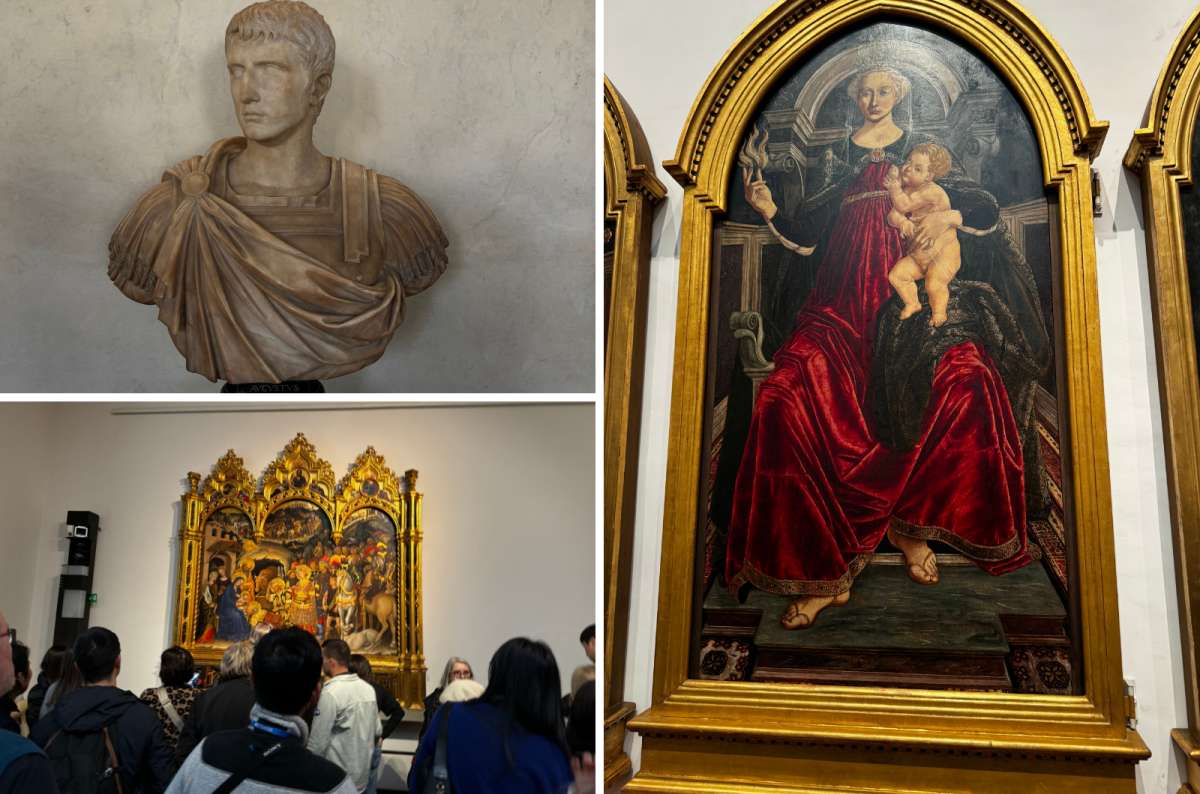
From Roman emperors to Renaissance masterpieces, the Uffizi Gallery in Florence ladies and gentlemen
- Distance from last stop: 300 meters / 0.19 miles—a 4-minute walk
- Time spent here: 2 hours (if you hurry)
- Book in advance? Yes. Even in low season, the line can stretch forever. The Uffizi is one of the busiest museums in Italy. You’ll get a timed ticket.
Visitor information:
- Tickets: EUR 25 for just Uffizi, EUR 43 for the Uffizi + Vasari Corridor, EUR 4 extra for advance booking (uncool!)
- Opening hours: Open from Tuesday to Sunday 8:15 am–6:30 pm, closed on Mondays
When I visited Florence, I had 9 am tickets for the Uffizi, and it was already packed, which tells you everything you need to know about how crowded it gets. Even in November, even with timed entry, the Uffizi is so packed I could barely see some of the paintings without three heads popping up in front of me. It's one of the most visited places in Italy for a reason—prepare to be gallery-ed to death.
What can you see in the Uffizi?
The Uffizi is full of art by Renaissance artists like Botticelli, Michelangelo, Leonardo da Vinci, Caravaggio, Raphael, Titian, Dürer, and things like ancient Roman statues and gold-covered altarpieces.
The first rooms are Roman statues, then come the medieval paintings where everyone looks mildly terrified and is covered in gold leaf. After that, the big names start.
Highlights from my Uffizi visit:
- Giovanni Giotto’s art stood out—his work has more contrast than anything else around it. You can tell when something’s by him because it doesn’t look like the others.
- Botticelli’s Birth of Venus is in a massive room full of people pretending to understand art. I am not an art guy myself, but seeing one of the most famous paintings in the world felt special even to me.
- Don’t miss the first floor—El Greco, Titian, Goya, Velázquez, Rembrandt, Rubens. Personally, the Dutch painters felt the most impressive.
- There’s also a section full of Caravaggio’s brutal stuff—decapitations, dark lighting, drama.
- Then there are the rooms of my egotistical German favorite, Albrecht Dürer. I’ve never seen such a big collection of Dürer in one place.
- One fun detail: painters back then obviously had no idea what people wore in the year 0, so they just dressed everyone in their own era’s fashion. Biblical scenes, but with 14th-century outfits.
- The Tribuna Room was closed for no clear reason, so that was a fail.
- The café upstairs has a great view of the Duomo, and more importantly, chairs.
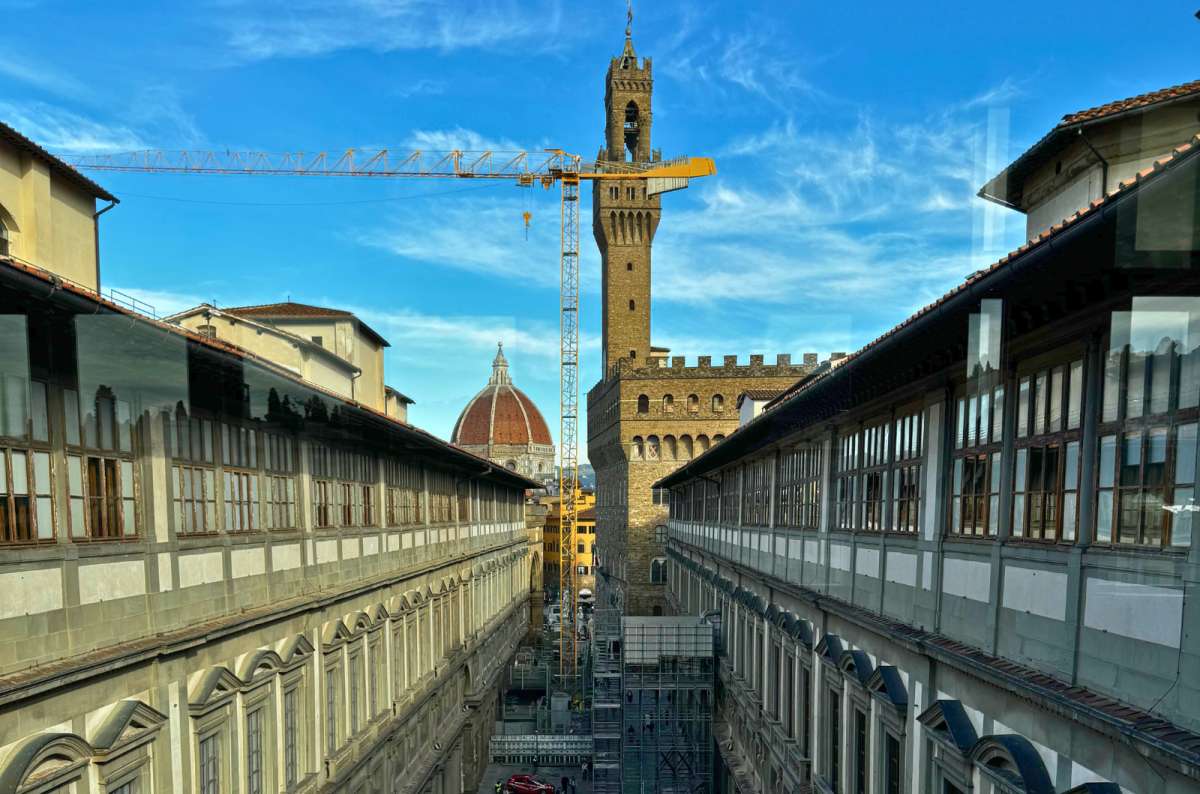
Need a break from all the things to do in Florence? The Uffizi café is the answer: epic Duomo views and, most importantly, chairs!
How long do you need in Uffizi?
If you try to hurry, you can get through in 2 hours. Skip the audio guide; the brief descriptions on the plaques are enough. You’d need half a day for anything more thorough. In the two hours I spent in Uffizi, I walked almost 6,000 steps. Good thing there’s a cafe at the end.
Is the Uffizi worth it?
Yes—if you’re prepared. It’s world-class art in a chaotic setting. Go early, book several weeks ahead, and don’t try to see everything.
To be honest, I expected more from Uffizi. I thought it would be a TOP TOP TOP museum like the Prado in Madrid, but it was only TOP. It’s great, but not you’ll-leave-humbled-and-sobbing amazing.
Optional extension: You can now enter the Vasari Corridor from Uffizi
After finishing the gallery visit, you enter the Vasari Corridor from inside the Uffizi. Here are the details:
Stop 4, day 2 (optional): Vasari Corridor—Florence’s Secret Passage (45 minutes)
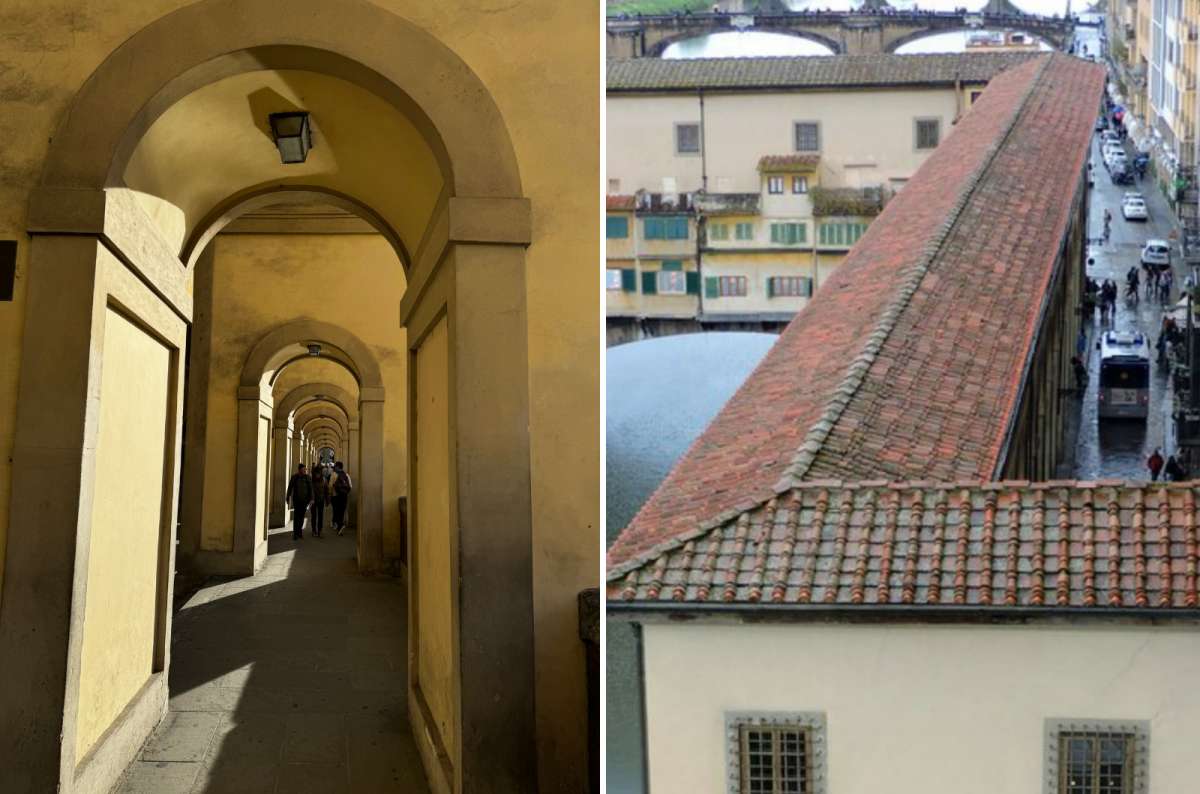
Walk in the footsteps of the Medici through the “hidden” Vasari Corridor—an underrated (and newly opened to the public!) gem on any 3-day Florence itinerary
- Distance from last stop: 0, you enter directly through Uffizi
- Time spent here: 45 minutes
- Book in advance? Yes, you need to book your time at the same time as your Uffizi visit
Visitor information:
- Tickets: EUR 43 for combo of Uffizi + Vasari Corridor (not sold separately), EUR 4 extra for advance booking
- Opening hours: Open whenever Uffizi is open
This next stop is almost a hidden gem in Florence—and I mean that literally. Built in 1565, the Vasari Corridor is a raised hallway that runs above the streets and over Ponte Vecchio, originally so the Medici could move between Palazzo Vecchio and Palazzo Pitti without mixing with the commoners.
For centuries, this secret passage was off-limits. Now, after an 8-year restoration, it’s finally open to the public again—just a few weeks after my trip, naturally.
Here's what you need to know about visiting the Vasari Corridor:
- You enter through the Uffizi Gallery—it’s part of a combined ticket, so you visit the museum first, then continue straight into the Corridor.
- You have to choose a time at least 2 hours after your Uffizi visit, otherwise they’ll have you sign a document saying you’re sane and really plan on flying through the Uffizi in a shorter time (really).
- It’s one-way only, about 1 km long, ending in Palazzo Pitti’s Ammannati Courtyard, via a quick detour through the Boboli Gardens.
- No stopping inside. No going back. The visit takes around 45 minutes, and you're gently herded through at a steady pace by a guide.
- You’ll walk above the Uffizi, cross over Ponte Vecchio, and snake through old buildings and rooftops you didn’t even realize had a secret hallway inside them.
Book your tickets early—time slot availability is limited. And if you’re planning your 3-day Florence itinerary around “unique things to do,” this is easily one of them.
Stop 5, day 2: Palazzo Pitti and Boboli Gardens—Medici Palace and the Best Garden Views in Florence (2–3 hours)
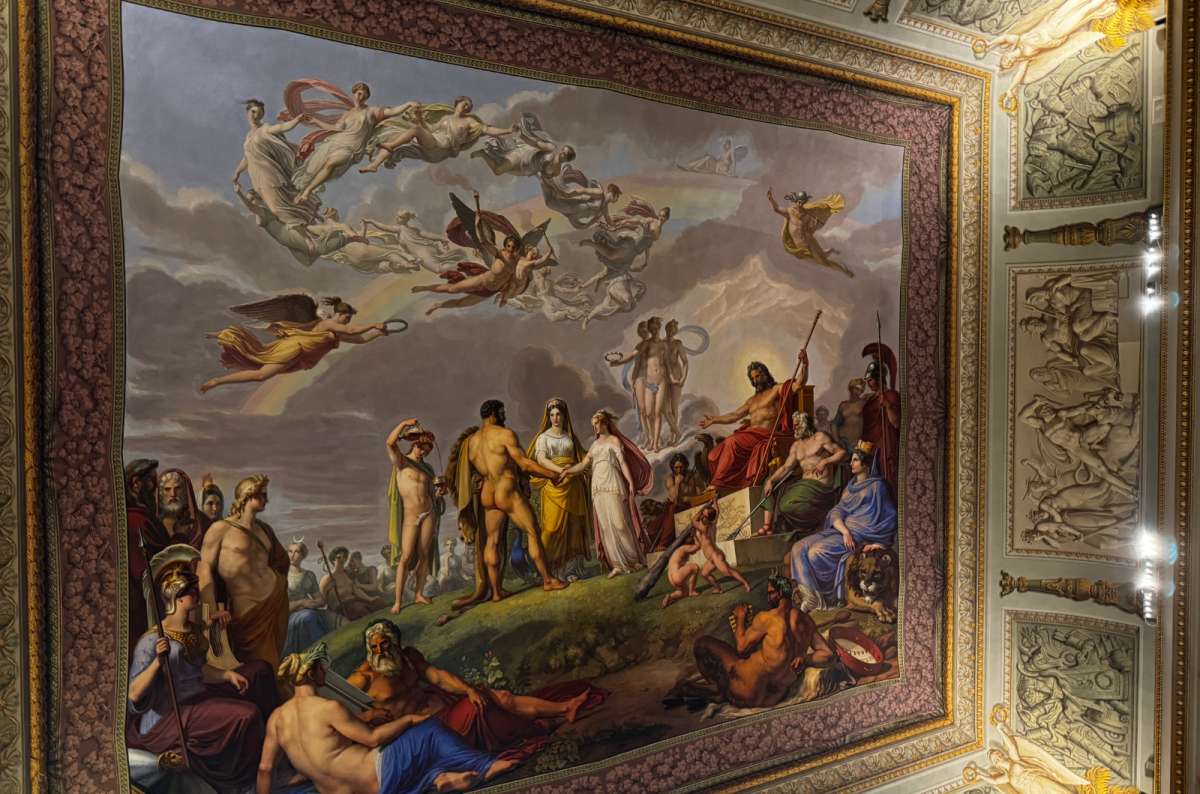
When your living room ceiling includes Greek gods, cupids, and flying muses @ Palatine Gallery in Palazzo Pitti
- Distance from last stop: 350 meters / 0.22 miles—5-minute walk from the Vasari Corridor exit or end of Ponte Vecchio
- Time spent here: 2–3 hours (including the palace and Boboli Gardens)
- Book in advance? Yes, in high season. For the combined Palazzo + Gardens ticket, booking online gets you a timed entry.
Visitor information:
- Tickets: EUR 22 for combined ticket for palace and gardens
- Opening hours: Open from Tuesday to Sunday usually 8.15 am–6:30, varies during every season, closed on Mondays
Whether you arrived here by walking over Ponte Vecchio or through the Vasari Corridor, Palazzo Pitti is next on your Florence itinerary—and it’s massive.
This was the Medici's actual house, and they weren’t exactly minimalists. (In case you need a refresher: the Medici were Florence’s ruling family, filthy rich bankers who basically funded the Renaissance.)
Expect metal detectors like at the airport and cloakrooms for your stuff.
The palace is divided into several museums: Royal Apartments, Palatine Gallery, Modern Art Gallery, a Fashion and Costume Museum, and the Treasury of the Grand Dukes.
If you move fast, give it about an hour. If you wander, it’ll easily take two—plus another hour if you want to see Boboli Gardens.
What to expect inside Palazzo Pitti
The collection is huge—honestly, it felt like there were more paintings than at the Uffizi. You’ll see big names like Tintoretto, Titian, Rubens, and Guido Reni, though it’s easy to get overwhelmed by just how much there is in here. My legs felt it too—I racked up almost 5,000 steps.
I sometimes stopped looking at the paintings and just stared at the beautiful ceilings instead.
Here are my notes from Palazzo Pitti:
- The modern art section (19th century, not contemporary) and the fashion museum are upstairs—fine to breeze through quickly unless you’re really into historical dresses or have a fashion-enthusiast in tow.
- The Russian Orthodox icons on the ground floor feel oddly out of place but are interesting.
- Don’t miss the Treasury of the Grand Dukes, hidden in a corner of the ground floor. It was refreshing to see something different—ivory, silver, and the kind of objects you imagine 16th-century weirdos hoarding.
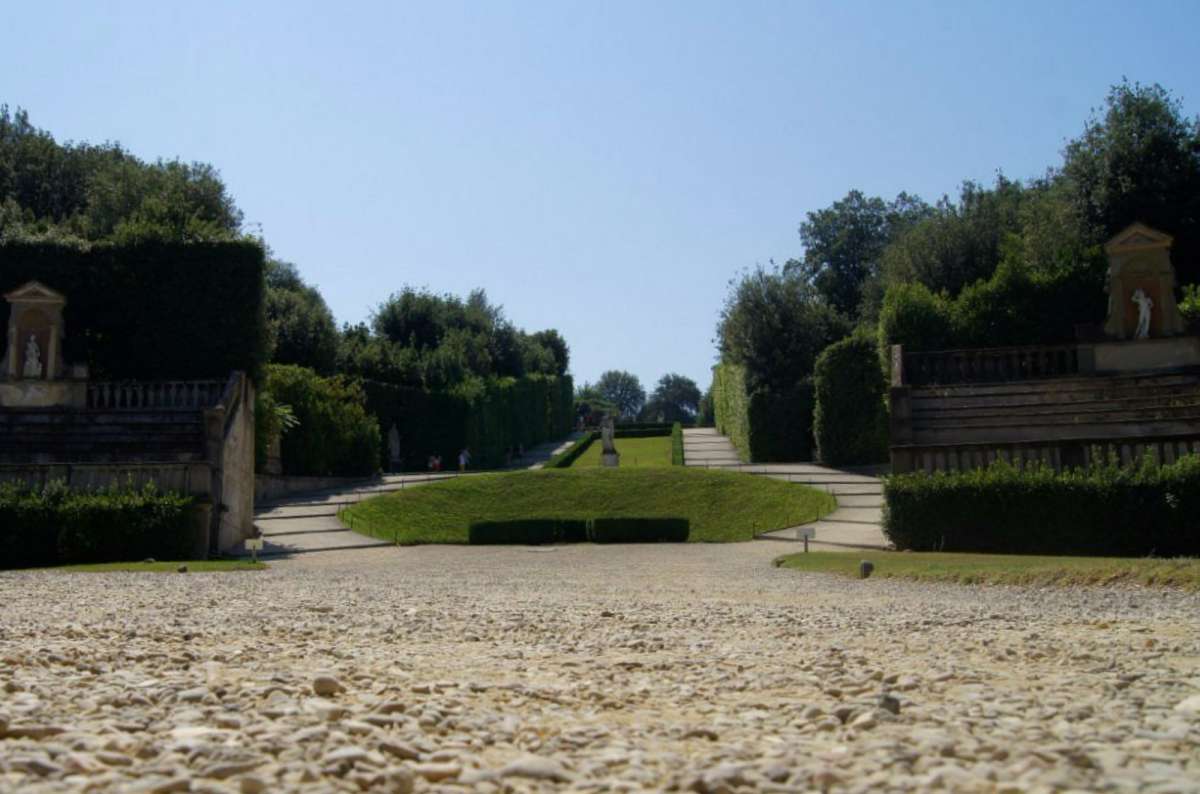
Welcome to the Boboli Gardens
Bonus: Boboli Gardens for some fresh air and views of Florence
After Palazzo Pitti, you can head straight into the Boboli Gardens that are right beside the palace. They’re huge, sloped, and manicured. You’ll get some of the best panoramas of Florence from up top.
If you’re short on time or energy, you can skip this stop and still have a great Florence trip. Mainly because up next is all about views and sunset at Piazzale Michelangelo.
Which is better: Boboli or Bardini Gardens?
Boboli is bigger and more famous. Bardini (next door) is smaller, quieter, and has slightly better views. If you're into formal hedges and gravel paths, choose Boboli. If you want a photo without 12 tourists in the background, try Bardini.

Stop 6, day 2: Piazzale Michelangelo & San Miniato—The best sunset spot in Florence (45 minutes)
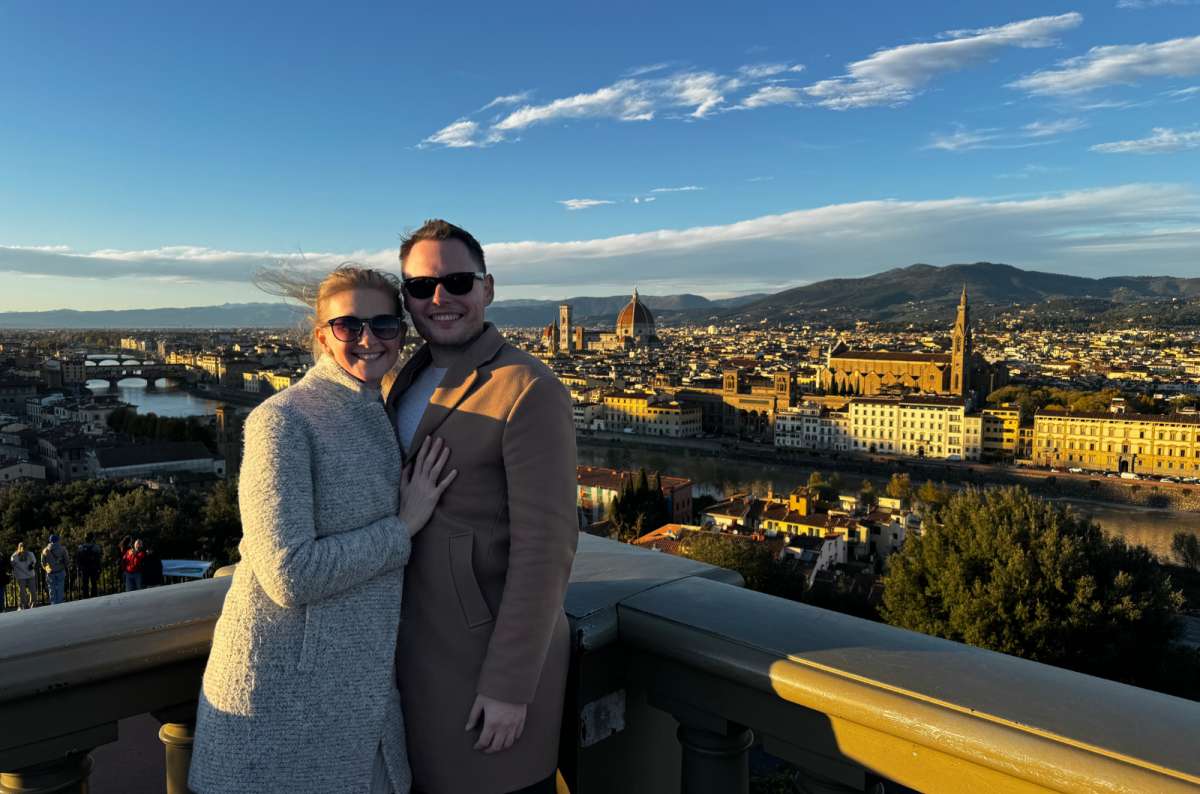
Piazzale Michelangelo offers the most iconic view of Florence
- Distance from last stop: 1,7 km / 1.1 miles, 25-minute walk
- Time spent here: 1 hour
- Book in advance? Nope, nothing to book
Visitor information:
- Tickets: free
- Opening hours: Open from Monday to Saturday 9:30 am–1:00 pm, 3:00 pm–7:00 pm and on Sunday 8:15 am–1:00 pm, 3:00 pm–7:00 pm
Where’s the best view of Florence?
Piazzale Michelangelo is where I found the best view of Florence. I recommend going about 45 minutes before sunset for the best light. If you want zero crowds, climb an extra five minutes higher to San Miniato al Monte.
To finish off the day, we followed the river and climbed to Piazzale Michelangelo. I strongly recommend taking the river route and not just walking through the city, it’s very pretty.
Once on top, the whole city spreads out below you: Duomo, tower, hills, all of it.
I went at golden hour, and if you’re going to do this too, that’s the time. About an hour before sunset, the light is perfect, and the crowd is bearable. People show up with wine and tripods, but no one’s loud. It’s weirdly respectful.
Just a bit higher is San Miniato al Monte, one of the oldest churches in Florence. Even if it gets too crowded at the viewpoint, there’ll be nobody up at the church, I promise.
Ready for your last day in Florence?
Day 3 of Your 3-Day Florence Itinerary—Unique Things to Do Before You Leave
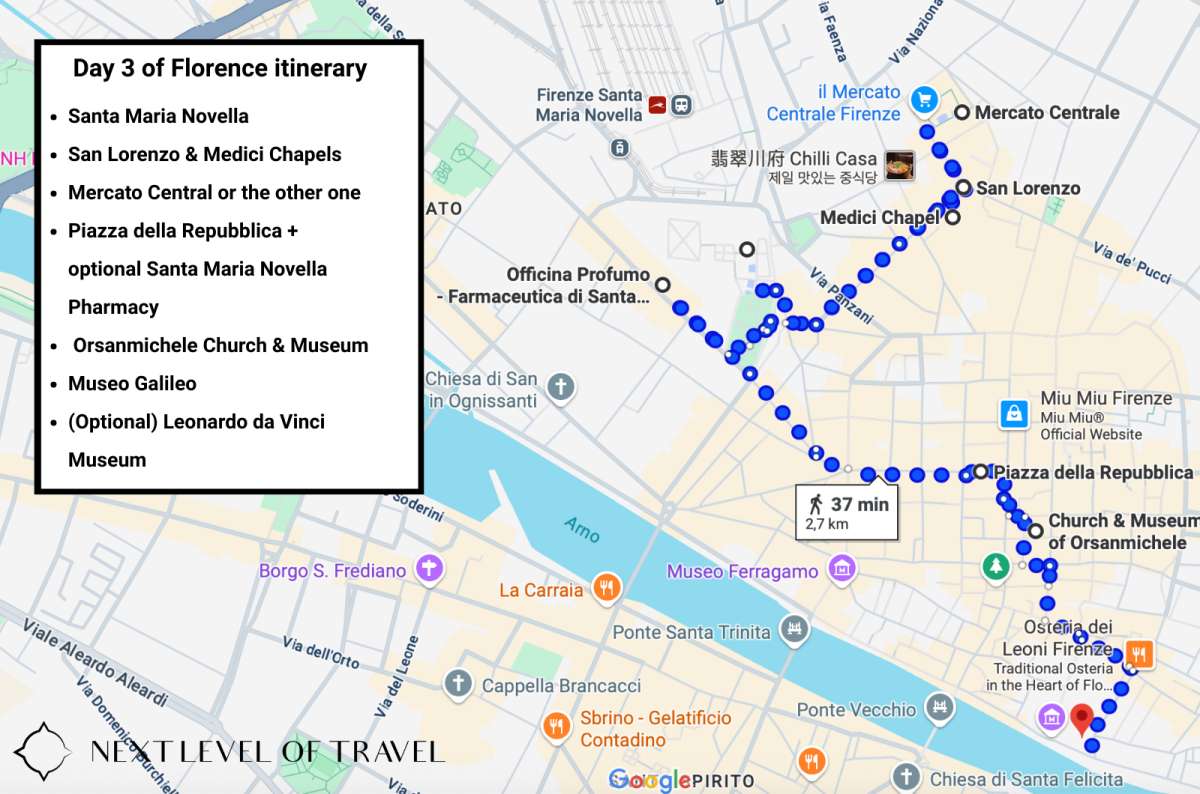
End your 3 days in Florence itinerary with science, scents, and serenity—visit hidden gems in Florence like Museo Galileo and the Medici Chapels
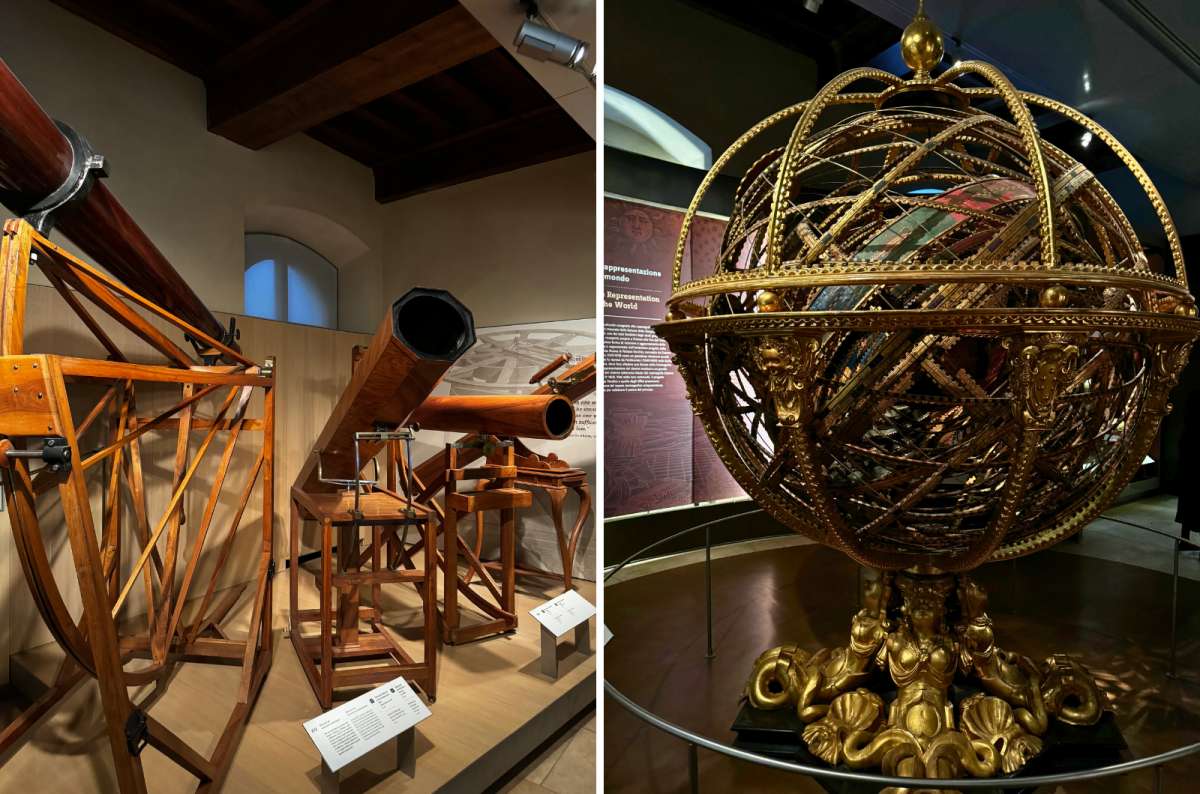
Museo Galileo
Main sites visited:
- Santa Maria Novella Basilica
- San Lorenzo + Medici Chapels
- Mercato Centrale
- Bonus stop: Officina Profumo-Farmaceutica di Santa Maria Novella and Piazza della Repubblica
- Orsanmichele Church & Museum
- Museo Galileo
Restaurant tips:
- Still time for another dinner at Osteria di Casa Chianti! Or explore something near the Oltrarno if you're not up for driving again.
Hotel recommendations:
Day 3 in this example of a 3-day itinerary in Florence focuses on some of the quieter spots and unique things to do in Florence. Perfect for when you’ve almost had enough cathedrals and art but aren’t ready to leave.
Stop 1, day 3: Santa Maria Novella—Florence’s Gothic Church with a Famous Facade (15–30 minutes)
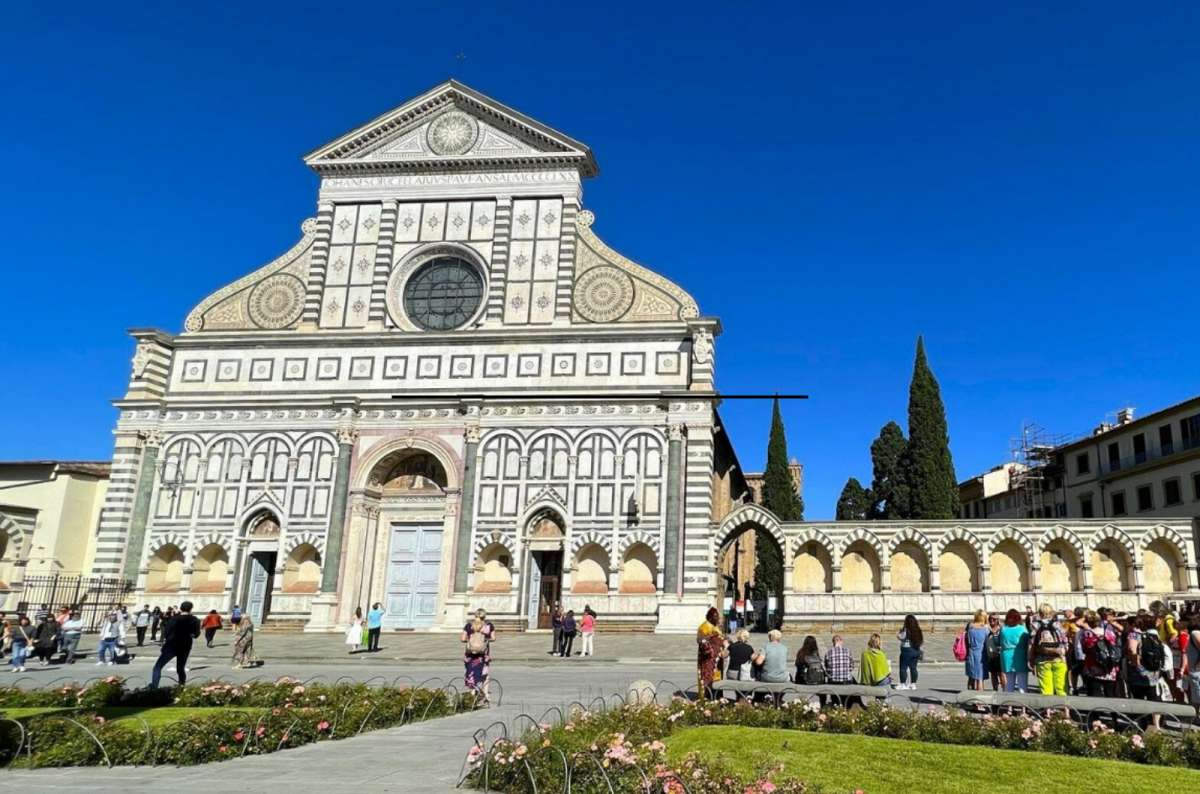
Santa Maria Novella’s elegant Renaissance façade marks the gateway to one of Florence’s oldest churches
- Time spent here: 15–30 minutes
- Book in advance? No
Visitor information:
- Tickets: EUR 7.50
- Opening hours: Open from Monday to Thursday 9:00 am–5:30 pm, on Saturday 9:00 am–5:00 pm and on Sunday 1:00 pm–5:00 pm
I started my last day in Florence a little bit outside the main tourist center. Not sure about you, but I was about to burst into flames by this point because of the non-stop tourist crowds at the city’s main attractions on my Florence itinerary, so this was a welcome respite.
The facade of Basilica of Santa Maria Novella is oddly satisfying in its geometry, and way bigger than I thought it would be. This thing would be a cathedral in every other city in Europe!
Inside I found tombs—so many tombs. I liked the nicely decorated Strozzi Chapel and the garden. Also, someone clearly summoned Voldemort here at some point—there are skulls with snakes coming out of their eye sockets. Maybe this is where Rowling got the idea.
All in all, Basilica of Santa Maria Novella was a pleasant surprise for me. Quiet, atmospheric, and a solid return on EUR 7.50.
Can you skip Santa Maria Novella?
You shouldn’t. It has a great interior, interesting historical context, and creepy tomb art. More interesting than San Lorenzo Basilica in my opinion (see next stop on this example itinerary for 3 days in Florence).
Stop 2, day 3: Basilica of San Lorenzo & Medici Chapels– Florence’s Oldest Church and Medici Tombs by Michelangelo (45 minutes)
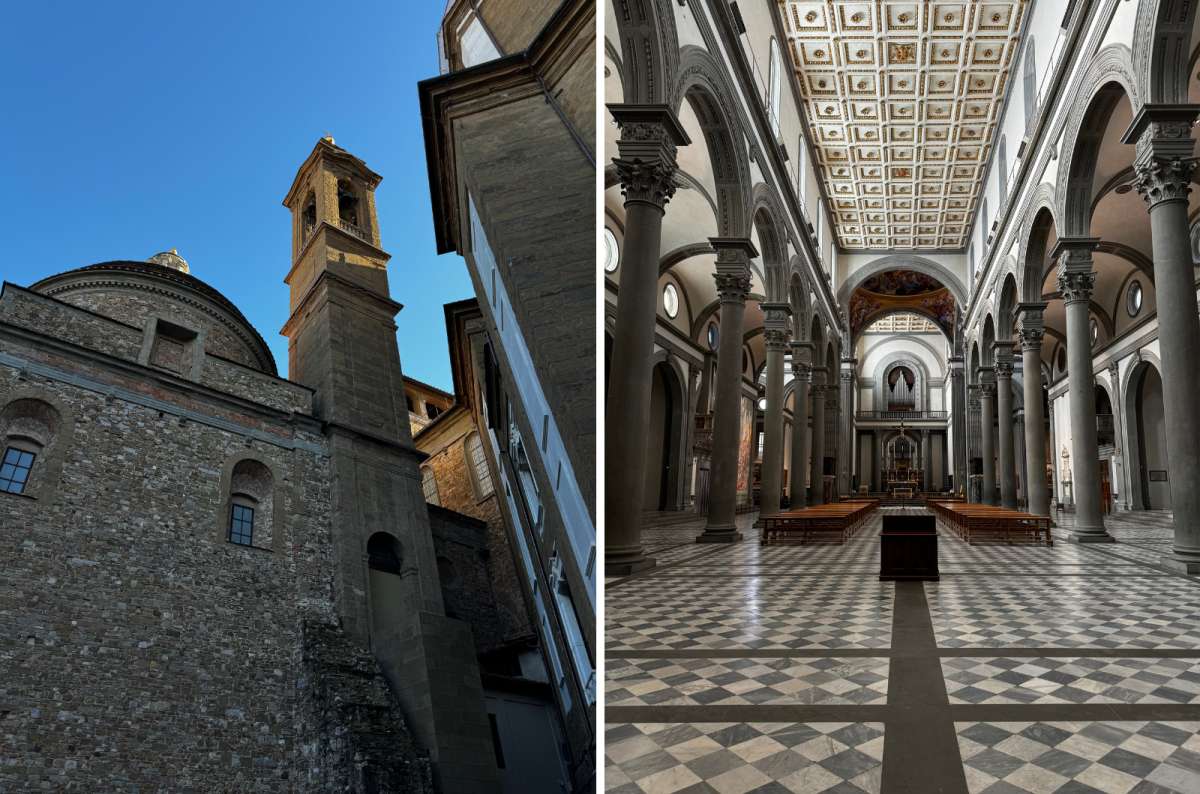
A must in your 3 days itinerary in Florence is Basilica di San Lorenzo—one of the city’s oldest churches
- Distance from last stop: 270 meters / 0.2 miles, a 5-minute walk
- Time spent here: 30–45 minutes
- Book in advance? No
Visitor information:
- Tickets: EUR 9 (Basilica of San Lorenzo) and EUR 9 (Medici Chapels)
- Opening hours: Basilica open from Monday to Saturday 10:30 am–5:30 pm and Medici Chapels open from Wednesday to Monday 8:15 am–6:50 pm

Don’t skip the Medici Chapels—Michelangelo’s Night and Day sculptures are a haunting masterpiece hidden in Florence
San Lorenzo Basilica is big but bare
From the Santa Maria Novella, I walked over to the next stop on this Florence itinerary, San Lorenzo Basilica. It’s one of Florence’s oldest and hugest churches. It’s certainly very big—the chapel is the size of a small cathedral, but kind of bare. It’s special because it’s the burial place of all the principal members of the Medici family.
The coolest part for me was the Old Sacristy, designed by Brunelleschi as a kind of mini-prototype before building the Duomo. If you care about architectural backstories, it’s a fun little “aha” moment.
The Medici Chapels are on the expensive side
I found the Medici Chapels next door more interesting. This is where all the main Medici family members, including Cosimo, are buried. You’ll find Michelangelo-designed tombs, decorative details, and a few smaller museum rooms and crypts as you walk through.
It’s more extensive than it first looks, but the EUR 9 (on top of the EUR 9 general basilica ticket) felt a bit steep, though it’s still a must-do on your Florence itinerary since the Medici’s were such a big deal here.

Stop 3, day 3: Mercato Centrale– Florence’s Best Food Market? (1 hour)
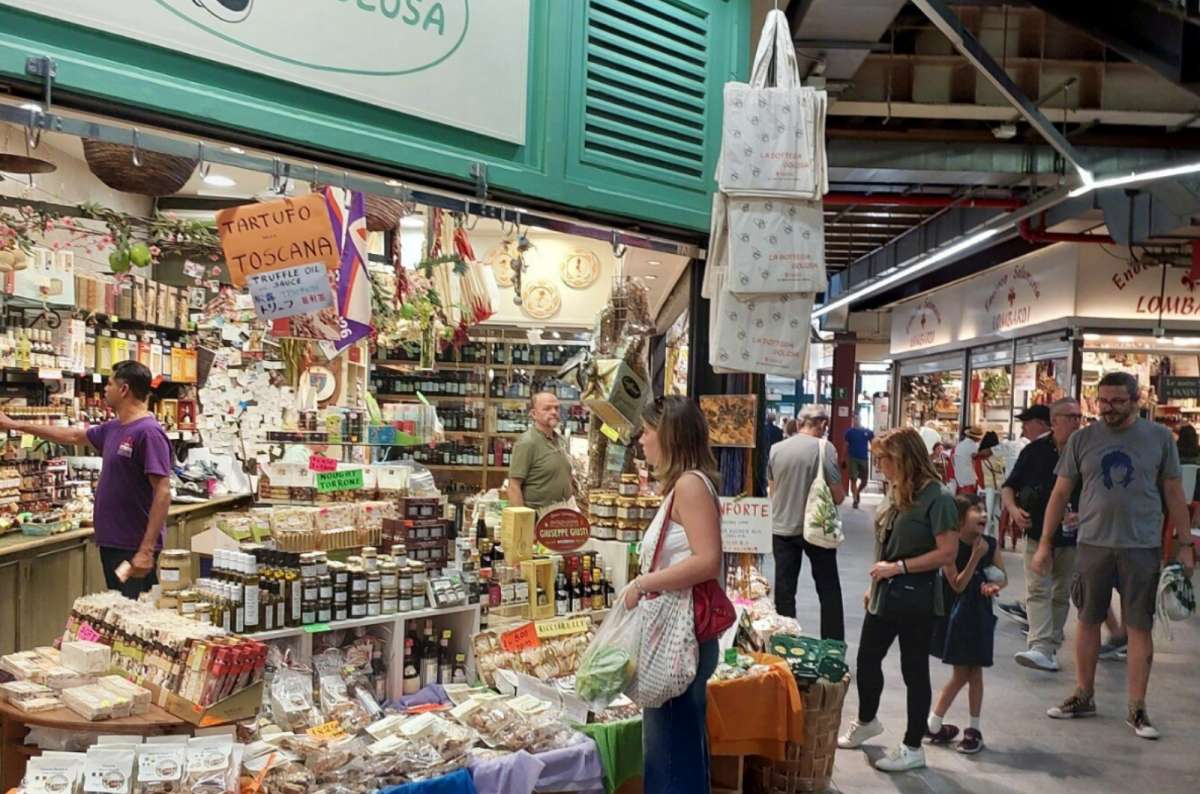
Mercato Centrale in Florence, perfect for a quick food stop
- Distance from last stop: 190 meters / 0.1 miles, 2-minute walk
- Time spent here: 1 hour
- Book in advance? No
Visitor information:
- Tickets: Free entry
- Opening hours: Ground floor (fresh produce) open from Monday to Saturday 7:00 am–2:00 pm and closed on Sundays. First floor (food court) is open daily from 9 am until midnight
I’m not a big market guy, but Mercato Centrale is just a few steps from San Lorenzo, I was hungry, and I wanted to see what the fuss was about—it seems every Florence itinerary mentions this place.
What I found was... a big food hall. No surprise there. The bottom floor is a traditional market (think vegetables, spices, slabs of meat). I dodged that and headed to the upper level instead. It’s food court-style and with everything from pasta and pizza to burgers and wine.
My verdict? It’s fine, but you don’t have to see it. It’s not exactly a local secret—but if you're wondering what to eat in Florence before visiting another church, Mercato Centrale will feed you.
Then, off I went to my next church—Orsanmichele.
Pro tip: If you hate markets more than I do, skip this stop and continue on to Piazza della Repubblica and find a place to eat there. The prices will be touristy, but the views are lovely. Head to the side alleys for less crazy prices.
Is Sant’Ambrogio better than Mercato Centrale?
Sant’Ambrogio is further out than Mercato Centrale, so it gets more locals and slightly less tourists. Otherwise, it seemed like more of the same to me. Food, produce, tables, nothing exhilarating.
Bonus Stop: Officina Profumo-Farmaceutica di Santa Maria Novella — The World’s Oldest Pharmacy & Piazza della Repubblica (30 minutes)
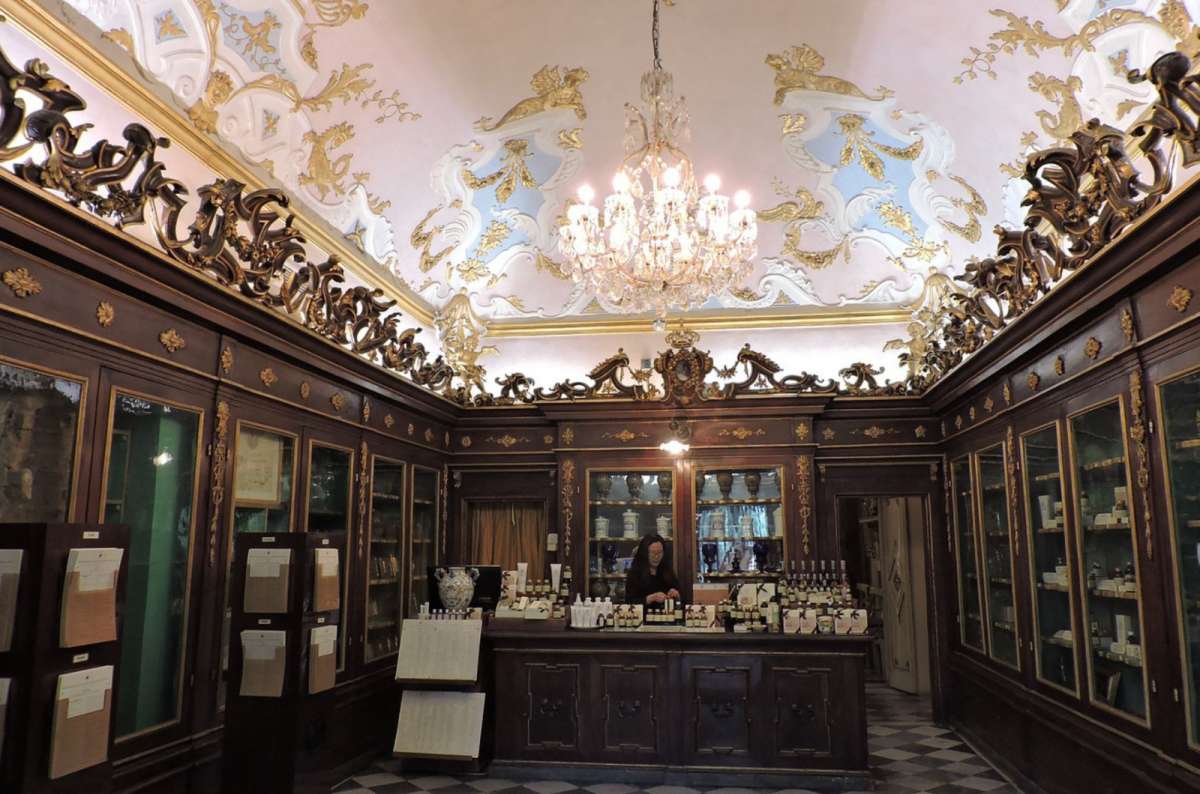
Officina Profumo-Farmaceutica di Santa Maria Novella is a time travel machine in a way
If you want to add a unique spot to your Florence itinerary, stop by the oldest pharmacy in the world on the way to your next stop, Orsanmichele Church.
It isn’t something I was dying to see, but since it was right there, I stepped in for a few minutes. Nowadays it’s mainly a perfume shop—you'll smell it before you see it.
Apparently, it was the monks from the monastery that started experimenting with herbal remedies and tinctures here in 1212.
The rooms look like mini palaces where the Medicis are still regular customers. There are antique wooden cabinets, old jars and vials, original paintings, etc.
It’s a real store, not a museum (but with lots of tourists loitering), so go ahead and buy a 200-euro hand cream in a gold-embossed box if that’s your thing.
Coffee stop at Piazza della Repubblica
If you’re craving a 4-euro espresso, now’s your chance. Piazza della Repubblica is one of Florence’s grander squares. Pass through or sit down at one of the cafes. You could even eat here if you skipped the central market.
Small reminder—if you wander just a block away, prices return to more acceptable levels.
Stop 4, day 3: Orsanmichele Church & Museum–Medieval Florence, Donatello Statues & Duomo Views (30 minutes)
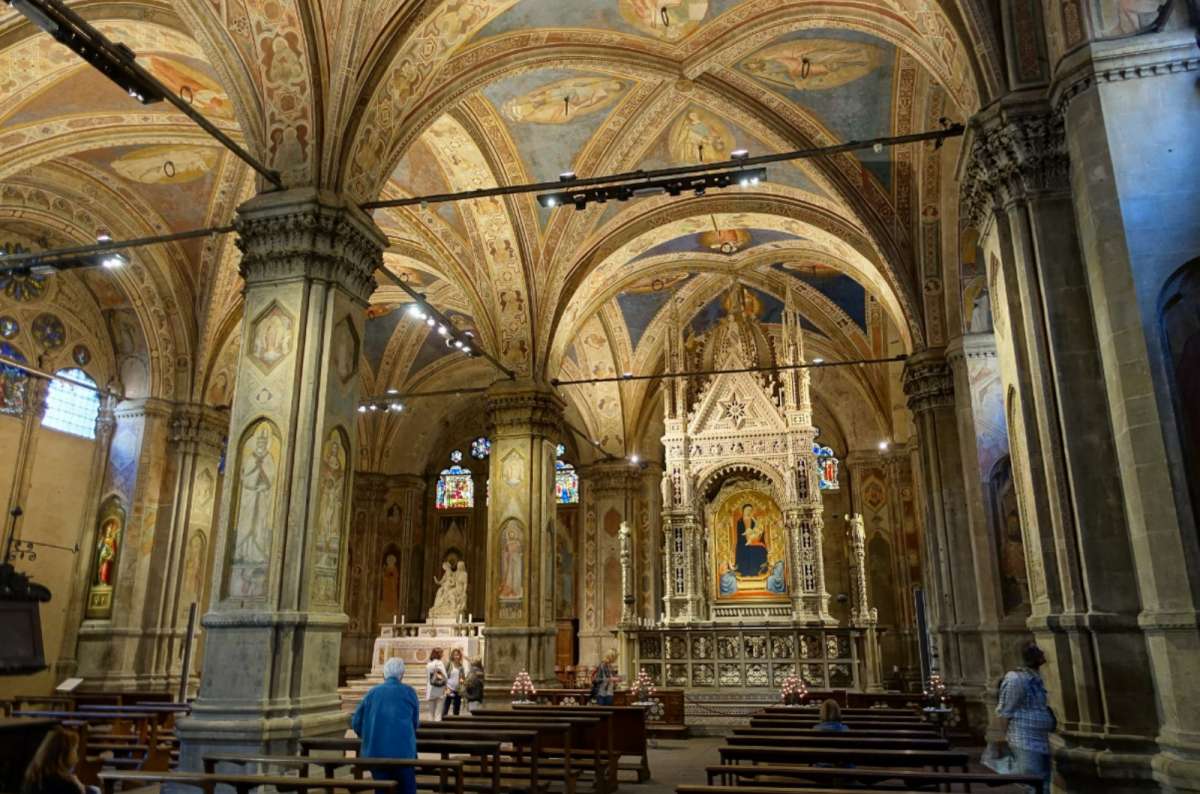
Make your 3-day Florence itinerary extra special with a visit to Orsanmichele, a hidden gem blending civic and religious history
- Distance from last stop: 350 meters / 0.2 miles, 5-minute walk
- Time spent here: 30 minutes
- Book in advance? No
Visitor information:
- Tickets: EUR 8
- Opening hours: Open on Monday to Saturday (except Tuesday) 8:15 am–6:30 pm and on Sunday 8:15 am–1:30 pm
Your 3 days in Florence are almost over! I never thought we’d get here, but I can finally say—there’s only one more church you need to see in Florence—Orsanmichele Church.
The first thing I noticed is how hard it is to photograph. I tried, but it’s crammed between narrow alleyways, and I just couldn’t get a decent shot. And then I couldn’t get a ticket!
Finding the ticket desk at Orsanmichele Church
Orsanmichele is worth stopping for what’s inside—if you can get in. Frustratingly enough, you don’t buy tickets at the door. I wandered around cluelessly before you figure out the ticket office is randomly placed on the opposite side of the building.
What’s inside Orsanmichele Church and Museum
Ticket finally in hand, I got inside. The building itself is from the 10th century and used to be a grain market, then a church, and now it’s sort of both. The ground floor still looks like a chapel, but the upstairs is a sculpture gallery with works by Donatello and other big names.
The museum part is technically across the street in another building (yes, more confusion!), and you snake your way up into the upper level above the church, where the art lives. It’s small but I liked it, and you get some great views of the Duomo from the windows.
Is it worth it?
Visiting Orsanmichele isn’t essential, but if you’ve got time on your Florence itinerary, it’s a nice break from the city’s mega-museums—with about 95% fewer people.
Honestly, if you're traveling on a tighter budget, you could skip it and the EUR 8 entrance fee. But if you're already doing the full 3-day Florence itinerary and want to check off your final Ninja Turtle, this is a must-visit. Between Raffaello (my favorite), Michelangelo, Donatello, and Leonardo, congratulations—you've now collected all four.
Stop 5, day 3: Museo Galileo–A Florence Must-See for Science Nerds (1 hour)
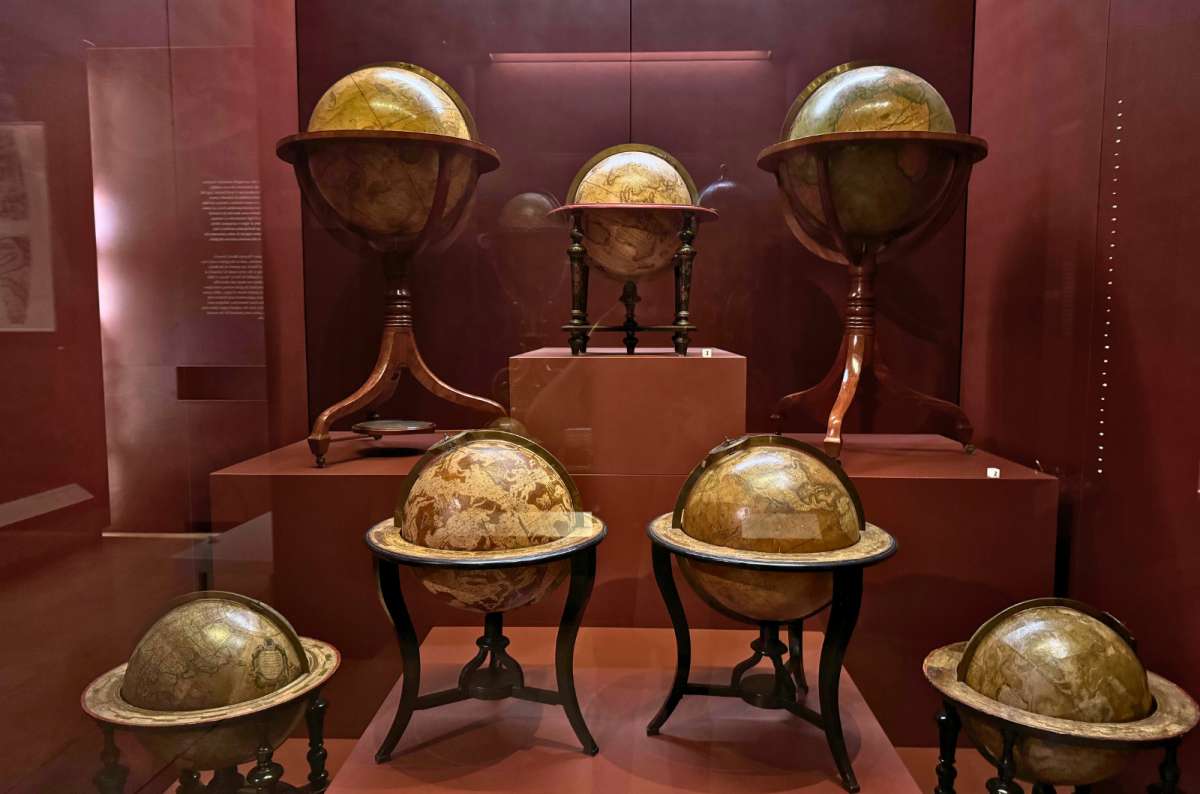
A stunning display of historical globes inside Museo Galileo
- Distance from last stop: 500 meters / 0.3 miles, 7-minute walk
- Time spent here: 1-hour minimum
- Book in advance? No
Visitor information:
- Tickets: EUR 13
- Opening hours: Open daily except for Tuesdays 9:30 am–6:00pm
I am leaving the Galileo Museum for the end of your Florence itinerary not because it’s not great—it is. It’s just because some of you will want to spend the rest of your time in Florence just sitting back and relaxing, so now’s your chance. Or maybe you’ll want to swap it for one of the many churches in Florence. But like I said—this place is a must-visit for anyone that loves science.
What to expect inside the Galileo Museum
The whole museum is built around the Medici’s obsession with scientific collecting. It’s a multi-floor museum focused on the birth of modern science in Europe, starting in the 16th century.
It’s wild to me how recent some of these massive discoveries actually are—and just how insanely fast everything has progressed in the last 100 years, or even just the last 20.
Highlights from the Galileo Museum:
- Enormous antique globes, complete with all the glorious mistakes—super fun to see.
- A surprisingly cool section on how people figured out longitude, and how geometry was once a military skill.
- Original telescopes that Galileo used.
- A whole exhibit on early weather instruments (a personal favorite).
- One gallery shows how electricity was already a major research obsession by 1750.
- Galileo’s actual finger is on display. Super random—but there it is, pointing forever.
This museum is genuinely unlike any other science museum I’ve been to. Highly recommended if you’ve got the curiosity left after 3 days in Florence.
Have More Time? The Best Day Trips from Florence

Exploring beyond Florence: add a trip to Lucca’s Duomo and the iconic Leaning Tower of Pisa to your Italian experience
If you’re lucky enough to have more than 3 days in Florence, there are some easy, high-impact day trips nearby that are absolutely worth your time.
Here are the ones I recommend—and have personally visited:
-
Pisa–The tower leans, but it’s Piazza dei Miracoli that really made me love Pisa.
-
Lucca–A pretty walled city with more locals than tourists, perfect for a half-day trip.
-
Siena–Worth it just for the Duomo complex—a striped, black and white marble wonder!
-
Or, head over to the Emilia Romagna region aka Italian food and fancy car heaven.

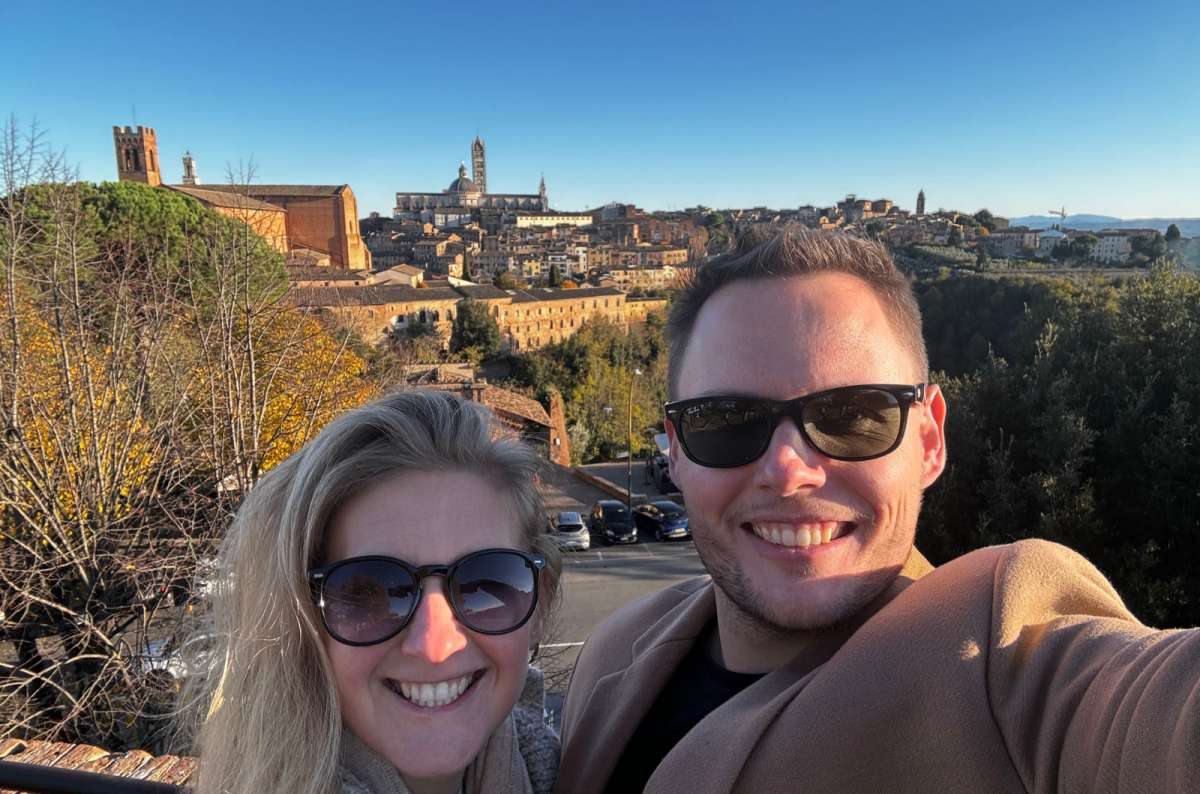
Siena—walk the ramparts of Fortezza Medicea for panoramic views
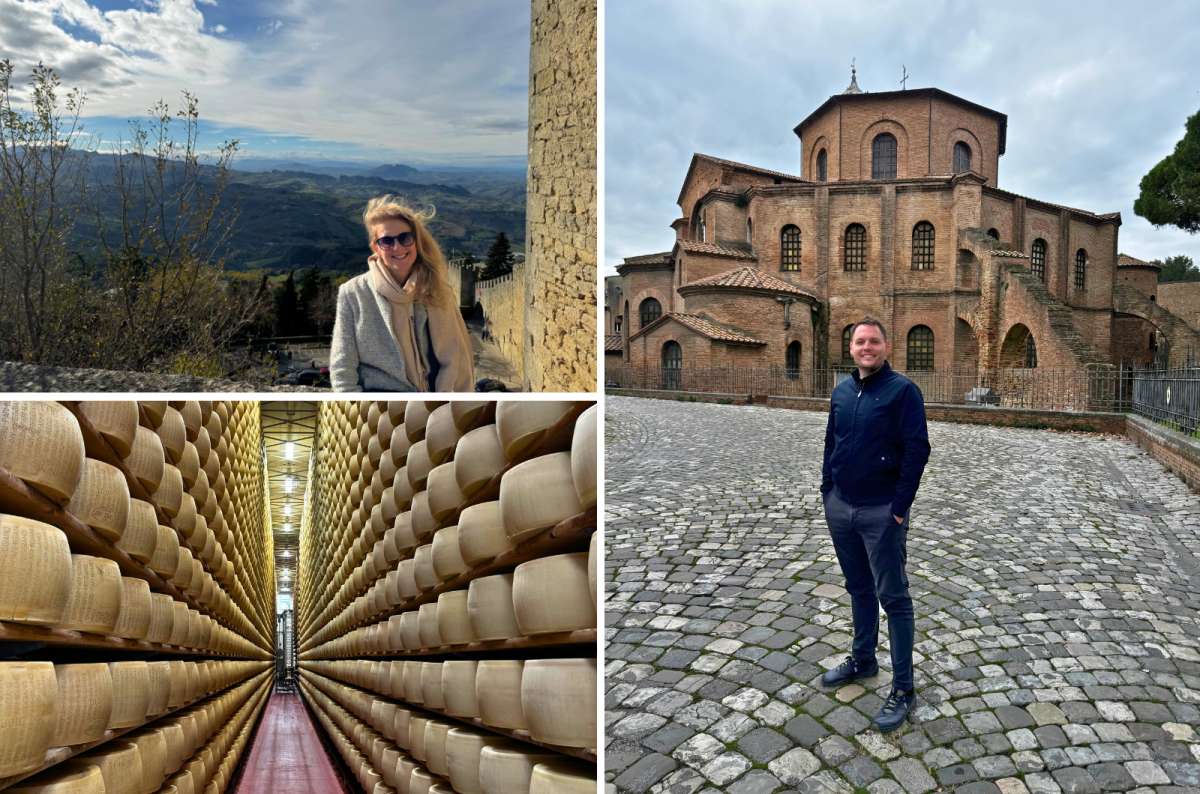
From medieval views in San Marino to cheese heaven and Byzantine beauty in Ravenna, this collage captures the essence of Emilia-Romagna
Florence Travel FAQ

From Florence’s Piazza della Repubblica to sacred sculptures in Museo dell’Opera del Duomo
How many days do you need in Florence?
You need at least 3 full days to see Florence properly without burning out. Two days is barely enough to rush through the highlights. With three, you can do the Duomo complex, Uffizi, David, Palazzo Pitti, and still have time to see a sunset without running.
What is the best way to get around Florence?
Walking. Always walking. The historic center is small and mostly pedestrian-only. If you're driving in Tuscany (like I did), park outside the ZTL and walk or take the tram in. Do not try to drive through Florence unless you enjoy Italian fines arriving six months later.
Do I need to buy tickets in advance for Florence attractions?
Yes. You'll want to plan ahead and get tickets in advance for everything that matters in Florence:
-
Uffizi Gallery
-
Accademia (David)
-
Duomo dome and bell tower climbs
Buy them online at least 2 weeks ahead. Even in off-season, the good slots go fast.
What’s included in the Duomo complex ticket?
One ticket covers six spots:
-
Cathedral (free anyway)
-
Brunelleschi’s Dome (must reserve)
-
Giotto’s Bell Tower
-
Baptistery
-
Santa Reparata (underground ruins)
-
Opera del Duomo Museum
It’s valid for 72 hours. Just don’t miss your timed slot for the dome or tower.
What’s better: climbing the Dome or the Bell Tower?
The dome is more iconic, but harder to book. The bell tower gives better views of the dome itself. If you can only do one, I say pick the Campanile (bell tower).
Is the Firenze Card worth it?
Not really. It’s expensive, doesn’t include everything (like the dome climb), and the “skip the line” perk often doesn’t work in practice. Buy individual tickets for the sights you actually want to see.
Is Florence walkable?
Florence is very walkable, but you will get your steps in (and then some). You can cross the entire historic center in 30 minutes. Bring good shoes—you’ll be walking 10,000–15,000 steps a day easily, with half of that inside the museums alone. Cobbled streets, museum staircases, bell towers... your legs will not be bored.
What are the best views in Florence?
-
Piazzale Michelangelo—the classic Florence skyline
-
San Miniato al Monte—same view, fewer people
-
Boboli Garden—for a greener, more regal view of the rooftops
-
Giotto’s Bell Tower—top-down view of the dome
-
Uffizi rooftop café—great photo stop if you’re already there
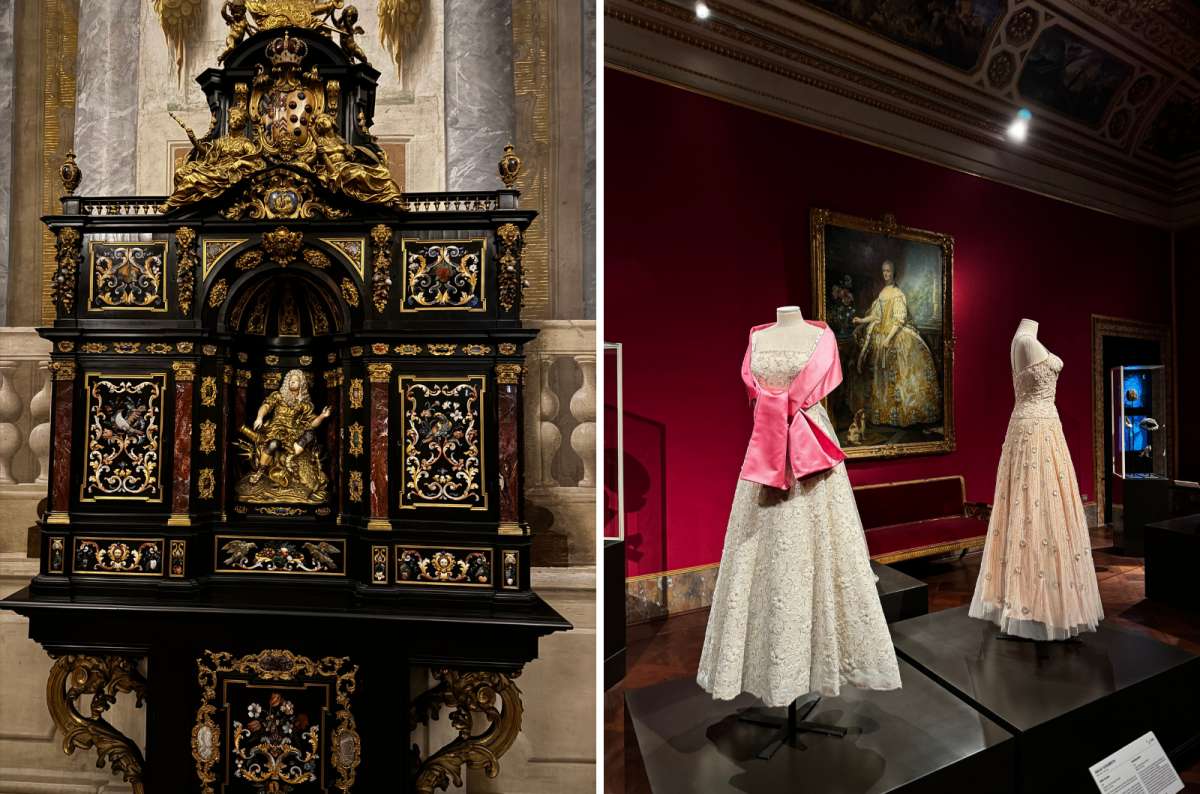
Baroque elegance and vintage fashion on display at Florence’s Pitti Palace
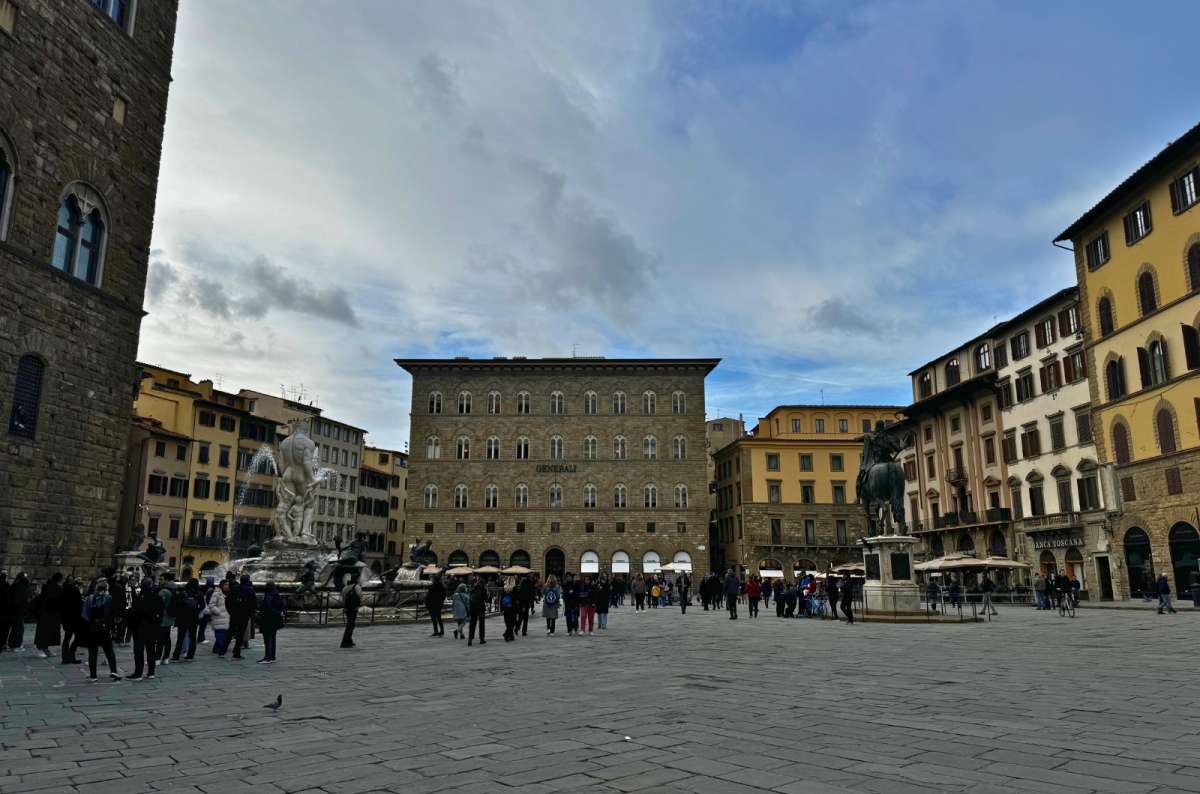
Piazza della Signoria during your visit is a must see
Sometimes, all you need to do is take the first step... I've filtered out the best hotels in Florence for you
Save it for yourself to come back to later, or share with your friends on social media!
This post contains affiliate links. If you make a booking through one of my links, I may earn a small commission—at no additional cost to you. Thank you for your support!
Overview of 3-Day Florence Itinerary: Step-by-step
Where I stayed in Florence: I Vivai
Day 1 of Your 3-Day Florence Itinerary—Duomo, David & the Florence Heavyweights
Stop 1, day 1: Florence Cathedral— Duomo di Firenze, Dome Climb & Full Ticket Guide (3–4 hours)
Stop 2, day 1: Galleria dell’Accademia—Where to Find Michelangelo’s David (45 minutes)
Optional stop 3: Bargello Gallery Florence—Hidden Gem for Renaissance Sculpture in Florence (1 hour)
Stop 4, day 1: Piazza della Signoria + Palazzo Vecchio (30 minutes)
Day 2 of Your 3-Day Florence Itinerary— Uffizi, Oltrarno Views, and Sunset Spots
Stop 2, day 2: Ponte Vecchio—Florence’s Iconic Bridge (10 minutes)
Stop 3, day 2: Uffizi Gallery–Botticelli, Da Vinci & Must-See Renaissance Art in Florence (2 hours)
Stop 4, day 2 (optional): Vasari Corridor—Florence’s Secret Passage (45 minutes)
Stop 6, day 2: Piazzale Michelangelo & San Miniato—The best sunset spot in Florence (45 minutes)
Stop 1, day 3: Santa Maria Novella—Florence’s Gothic Church with a Famous Facade (15–30 minutes)
Stop 3, day 3: Mercato Centrale– Florence’s Best Food Market? (1 hour)
Stop 5, day 3: Museo Galileo–A Florence Must-See for Science Nerds (1 hour)
Have More Time? The Best Day Trips from Florence
How many days do you need in Florence?
What is the best way to get around Florence?
What’s better: climbing the Dome or the Bell Tower?
What’s included in the Duomo complex ticket?
Do I need to buy tickets in advance for Florence attractions?




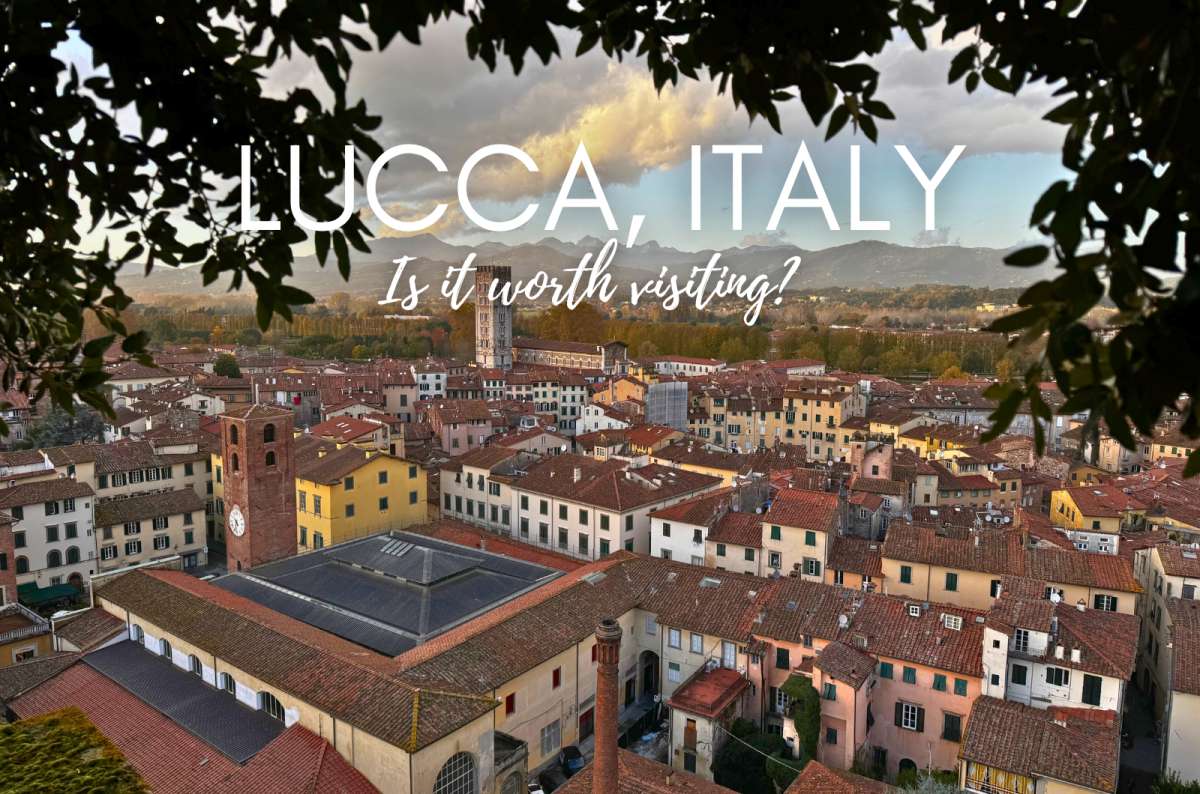
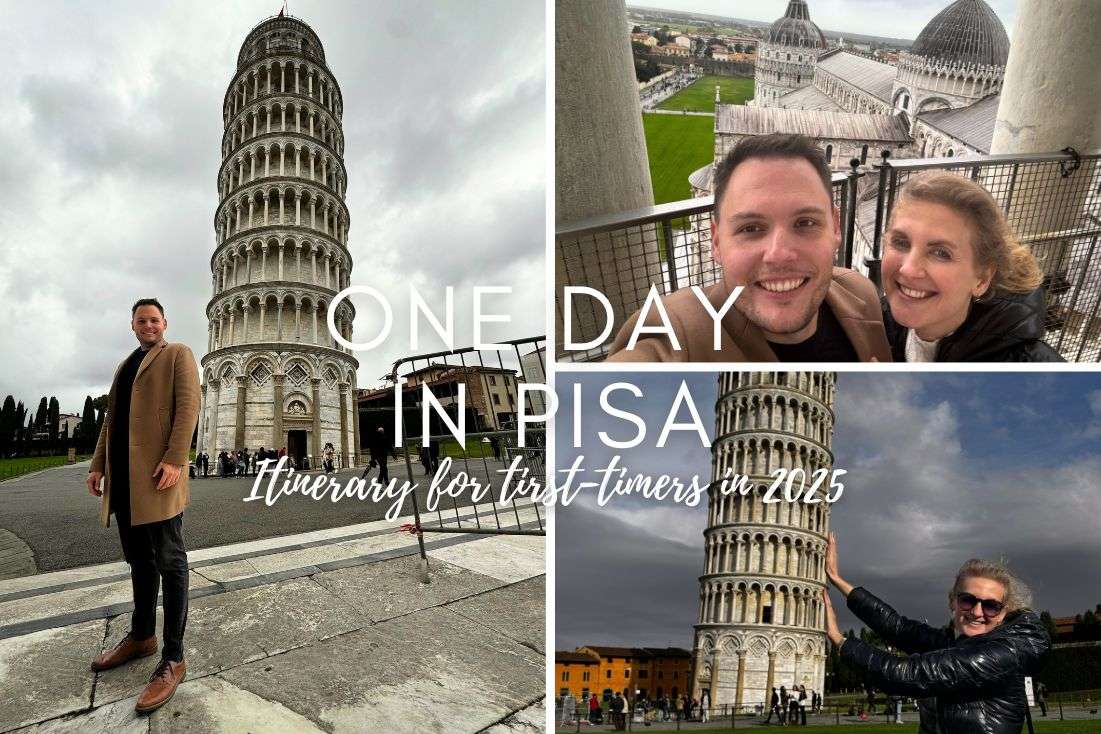




Comments | Thoughts? Give us a shout!